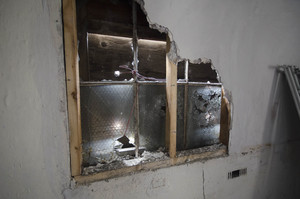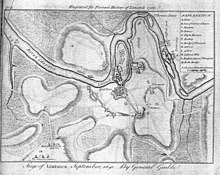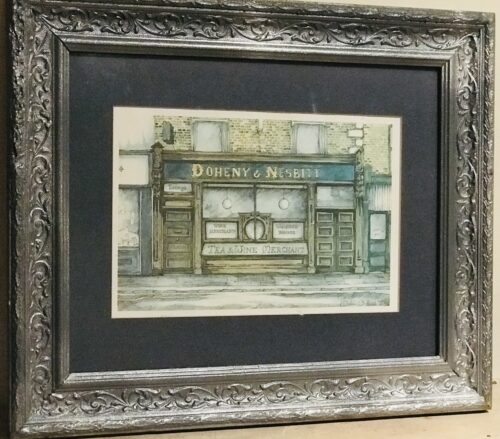-
Out of stock
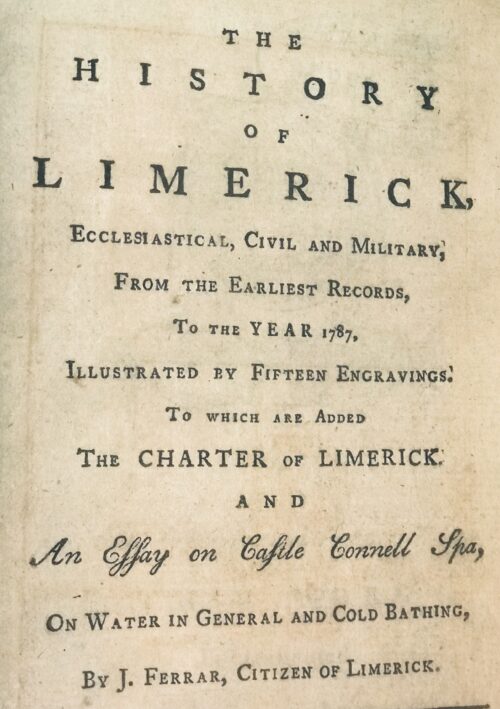
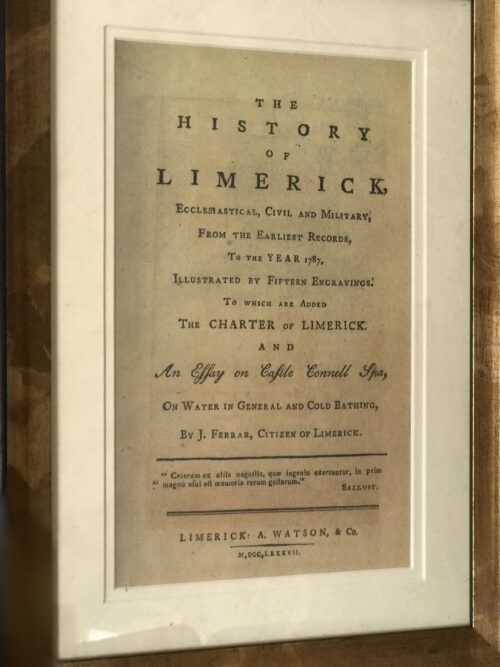 Ferrars History of Limerick was first published in 1787.There are very few copies still in existence and these 5 prints were generously taken from 16 original engravings in the first edition .They depict the Siege of Limerick in 1691,St Marys Cathedral,De Burgos Castle in Castleconnell,The Exchange building and the first page of the book. 35cm x 40cm LimerickThe History of Limerick by James Ferrar published in 1787 is a history of Limerick city from ancient times until the late 18th century. Limerick was an important medieval stronghold, became an important port and trading centre, was subject to a series of sieges in the 17th century and finally experienced a brief golden age of prosperity during the Georgian period of the late 18th century. Limerick or Luimneach was an ancient settlement long before the Vikings captured it and established their own town there in the 9th century. They used it as a base for trade and also to launch raids up the River Shannon against monastic sites like Clonmacnoise and other wealthy Christian centres. However in the 11th century the last Viking king of Limerick was defeated by King Brian Boru. In 1174, the Norman conquerors who had already seized Dublin , Leinster and Munster captured the city of Limerick . It was given its city charter by King Richard I in 1197 and a castle fortress was built by King John about 1200. The medieval city featured a walled town known as Englishtown on the north side of the River Shannon. Irishtown was inhabited by the Irish and Vikings was on the south side of the river. Both were eventually walled and linked by bridges over the Shannon . Limerick would retain formidable defenses until the 17th century when it experienced four separate sieges during the period of the English Civil War and the Williamite Wars. Catholic rebels forced the English garrison to surrender in 1642 and a Parliamentarian Army in turn forced a Catholic and Royalist garrison to surrender in 1651. It was twice besieged in 1690 and 1691 by the forces of William III of Orange who forced Jacobins fighting on the sides of the Catholic James II to surrender and go into exile. From the late 17th to the 19th centuries an Anglo-Irish Protestant elite controlled Ireland . In Limerick in the late 1700s Limerick merchants prospered and Edmund Pery, 1st Viscount Pery had much of the south side of the city redesigned with a grid of Georgian brick terraces and neo-classical stone buildings. The Georgian area still survives in the 21st century and Prey Square is named in Edmund Prey's honour. Unfortunately the Irish economy declined in the early 19th century as the Irish Parliament was switched from College Green, Dublin to the House of Commons in London and Ireland remained a near feudal agricultural society as Britain rapidly industrialised. Like Dublin , Limerick 's best days were behind it as slums flourished and in the 1840s the city population swelled as the poor fled from the land after the failure of the potato crop.
Ferrars History of Limerick was first published in 1787.There are very few copies still in existence and these 5 prints were generously taken from 16 original engravings in the first edition .They depict the Siege of Limerick in 1691,St Marys Cathedral,De Burgos Castle in Castleconnell,The Exchange building and the first page of the book. 35cm x 40cm LimerickThe History of Limerick by James Ferrar published in 1787 is a history of Limerick city from ancient times until the late 18th century. Limerick was an important medieval stronghold, became an important port and trading centre, was subject to a series of sieges in the 17th century and finally experienced a brief golden age of prosperity during the Georgian period of the late 18th century. Limerick or Luimneach was an ancient settlement long before the Vikings captured it and established their own town there in the 9th century. They used it as a base for trade and also to launch raids up the River Shannon against monastic sites like Clonmacnoise and other wealthy Christian centres. However in the 11th century the last Viking king of Limerick was defeated by King Brian Boru. In 1174, the Norman conquerors who had already seized Dublin , Leinster and Munster captured the city of Limerick . It was given its city charter by King Richard I in 1197 and a castle fortress was built by King John about 1200. The medieval city featured a walled town known as Englishtown on the north side of the River Shannon. Irishtown was inhabited by the Irish and Vikings was on the south side of the river. Both were eventually walled and linked by bridges over the Shannon . Limerick would retain formidable defenses until the 17th century when it experienced four separate sieges during the period of the English Civil War and the Williamite Wars. Catholic rebels forced the English garrison to surrender in 1642 and a Parliamentarian Army in turn forced a Catholic and Royalist garrison to surrender in 1651. It was twice besieged in 1690 and 1691 by the forces of William III of Orange who forced Jacobins fighting on the sides of the Catholic James II to surrender and go into exile. From the late 17th to the 19th centuries an Anglo-Irish Protestant elite controlled Ireland . In Limerick in the late 1700s Limerick merchants prospered and Edmund Pery, 1st Viscount Pery had much of the south side of the city redesigned with a grid of Georgian brick terraces and neo-classical stone buildings. The Georgian area still survives in the 21st century and Prey Square is named in Edmund Prey's honour. Unfortunately the Irish economy declined in the early 19th century as the Irish Parliament was switched from College Green, Dublin to the House of Commons in London and Ireland remained a near feudal agricultural society as Britain rapidly industrialised. Like Dublin , Limerick 's best days were behind it as slums flourished and in the 1840s the city population swelled as the poor fled from the land after the failure of the potato crop. -
Out of stock
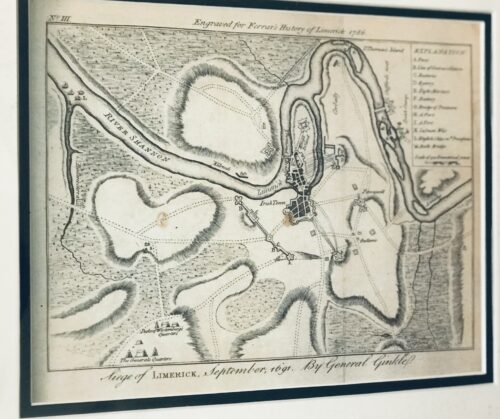
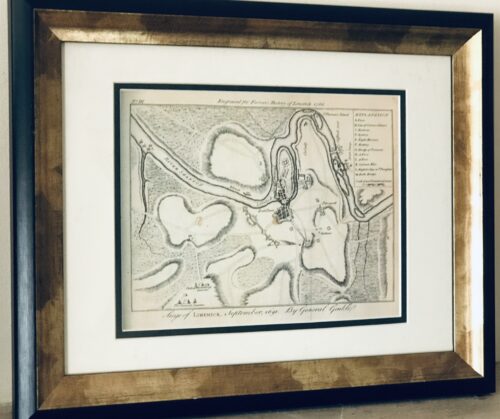 The Siege of Limerick 1691 from the definitive Ferrars History of Limerick was first published in 1787 There are very few copies still in existence and these 5 prints were generously taken from 16 original engravings in the first edition . 35cm x 40cm Limerick The Siege of Limerick in western Ireland was a second siege of the town during the Williamite War in Ireland (1689–1691). The city, held by Jacobite forces was able to beat off a Williamite assault in 1690. However, after a second siege in August–October 1691, it surrendered on favourable terms. By the time of the second siege, the military situation had turned against the Jacobites; their main force had been badly defeated at the Battle of Aughrim in July, with over 4,000 killed, including their commander, the Marquis de St Ruth, and thousands more either taken prisoner or deserted. The town of Galway capitulated in July 1691; its Jacobite garrison was accorded 'all the honours of war,' which allowed them to retain their weapons and receive a free pass to Limerick. However, although its defences had been considerably strengthened since 1690, morale was now much lower after a series of defeats and retreats. By now, siege warfare was an exact art, the rules of which were so well understood wagering on their outcome and duration had become a popular craze; the then enormous sum of £200,000 was alleged to have been bet on the siege. The Williamite general Godert de Ginkell surrounded the city and bombarded it, tearing a breach in the walls of English town. A surprise Williamite attack drove the Irish defenders from the earthworks defending Thomond bridge, sending its Irish defenders reeling back towards Limerick. The French defenders of the main gate of the city refused to open it for the fleeing Irish and about 800 of them were cut down or drowned in the river Shannon.
The Siege of Limerick 1691 from the definitive Ferrars History of Limerick was first published in 1787 There are very few copies still in existence and these 5 prints were generously taken from 16 original engravings in the first edition . 35cm x 40cm Limerick The Siege of Limerick in western Ireland was a second siege of the town during the Williamite War in Ireland (1689–1691). The city, held by Jacobite forces was able to beat off a Williamite assault in 1690. However, after a second siege in August–October 1691, it surrendered on favourable terms. By the time of the second siege, the military situation had turned against the Jacobites; their main force had been badly defeated at the Battle of Aughrim in July, with over 4,000 killed, including their commander, the Marquis de St Ruth, and thousands more either taken prisoner or deserted. The town of Galway capitulated in July 1691; its Jacobite garrison was accorded 'all the honours of war,' which allowed them to retain their weapons and receive a free pass to Limerick. However, although its defences had been considerably strengthened since 1690, morale was now much lower after a series of defeats and retreats. By now, siege warfare was an exact art, the rules of which were so well understood wagering on their outcome and duration had become a popular craze; the then enormous sum of £200,000 was alleged to have been bet on the siege. The Williamite general Godert de Ginkell surrounded the city and bombarded it, tearing a breach in the walls of English town. A surprise Williamite attack drove the Irish defenders from the earthworks defending Thomond bridge, sending its Irish defenders reeling back towards Limerick. The French defenders of the main gate of the city refused to open it for the fleeing Irish and about 800 of them were cut down or drowned in the river Shannon.Capitulation and treaty
After this point, Patrick Sarsfield ousted the Chevalier de Tessé and the Marquis d'Usson, the French commanders in Limerick, and began negotiations to surrender. He and Ginkel concluded a treaty that promised to respect the civilian population of Limerick, tolerate the Catholic religion in Ireland, guarantee against the confiscation of Catholic-owned land and allow Sarsfield and the fully-armed Jacobite army to withdraw to France. Limerick capitulated under those favourable terms in October 1691. Sarsfield left Ireland with 10,000 soldiers and 4,000 women and children to enter the French service, a journey that has become known as the Flight of the Wild Geese. The terms of the Treaty of Limerick were not honoured by the 1697 Protestant-dominated Irish Parliament, and Catholics were subjected to the continuous oppression of the Penal Laws, which discriminated against them until the early 19th centuryThe History of Limerick by James Ferrar published in 1787 is a history of Limerick city from ancient times until the late 18th century. Limerick was an important medieval stronghold, became an important port and trading centre, was subject to a series of sieges in the 17th century and finally experienced a brief golden age of prosperity during the Georgian period of the late 18th century. Limerick or Luimneach was an ancient settlement long before the Vikings captured it and established their own town there in the 9th century. They used it as a base for trade and also to launch raids up the River Shannon against monastic sites like Clonmacnoise and other wealthy Christian centres. However in the 11th century the last Viking king of Limerick was defeated by King Brian Boru. In 1174, the Norman conquerors who had already seized Dublin , Leinster and Munster captured the city of Limerick . It was given its city charter by King Richard I in 1197 and a castle fortress was built by King John about 1200. The medieval city featured a walled town known as Englishtown on the north side of the River Shannon. Irishtown was inhabited by the Irish and Vikings was on the south side of the river. Both were eventually walled and linked by bridges over the Shannon . Limerick would retain formidable defenses until the 17th century when it experienced four separate sieges during the period of the English Civil War and the Williamite Wars. Catholic rebels forced the English garrison to surrender in 1642 and a Parliamentarian Army in turn forced a Catholic and Royalist garrison to surrender in 1651. It was twice besieged in 1690 and 1691 by the forces of William III of Orange who forced Jacobins fighting on the sides of the Catholic James II to surrender and go into exile. From the late 17th to the 19th centuries an Anglo-Irish Protestant elite controlled Ireland . In Limerick in the late 1700s Limerick merchants prospered and Edmund Pery, 1st Viscount Pery had much of the south side of the city redesigned with a grid of Georgian brick terraces and neo-classical stone buildings. The Georgian area still survives in the 21st century and Prey Square is named in Edmund Prey's honour. Unfortunately the Irish economy declined in the early 19th century as the Irish Parliament was switched from College Green, Dublin to the House of Commons in London and Ireland remained a near feudal agricultural society as Britain rapidly industrialised. Like Dublin , Limerick 's best days were behind it as slums flourished and in the 1840s the city population swelled as the poor fled from the land after the failure of the potato crop.
-
Out of stock
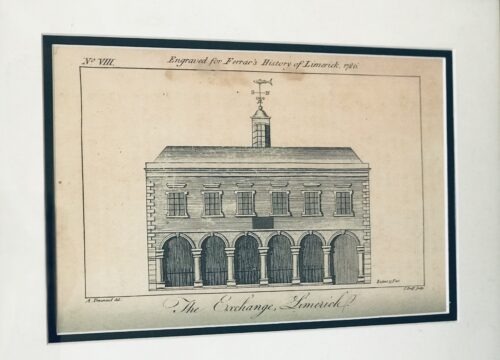
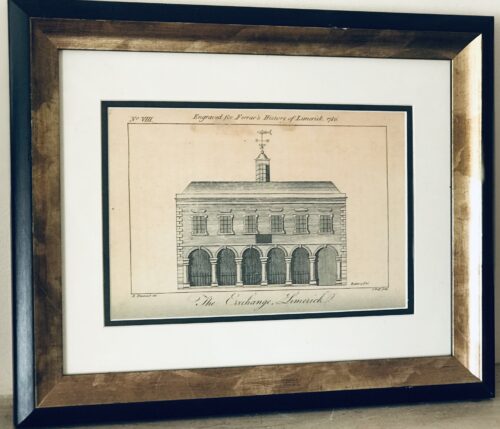 Superb print of The Exchange Limerick from Ferrars History of Limerick,first published in 1787.There are very few copies still in existence and these 5 prints were generously taken from 16 original engravings in the first edition . 35cm x 40cm Limerickrcaded six-bay single-storey limestone exterior wall forming the remains of the former Exchange, originally built in 1673, rebuilt in 1702 and again in between 1777-78. Forms part of the wall which surrounds Saint Mary's Cathedral graveyard and faces onto Nicholas Street. Historically in use as an evening national school. Now much obscured by vegetative growth. The blind arcade of seven arches is formed by half-engaged Tuscan columns standing on limestone base, breaking to centre arch and end bay to west. Profiled archivolts unseen. Entablature to parapet obscured. Roughly squared and coursed rubble limestone infill between arches. At either end is an ashlar limestone pier engaged with end columns, giving strength of composition to the broad intercolumniation. Plaque to Cathedral wall reads: This Exchange Was Rebuilt At Expense Of The Corporation Of Limerick The First Year Of The Reign Of Queen Anne Anno Dom 1702 William Davis Esquire Mayor Rawley Colroys Robert Wilkinson Sheriffs'.
Superb print of The Exchange Limerick from Ferrars History of Limerick,first published in 1787.There are very few copies still in existence and these 5 prints were generously taken from 16 original engravings in the first edition . 35cm x 40cm Limerickrcaded six-bay single-storey limestone exterior wall forming the remains of the former Exchange, originally built in 1673, rebuilt in 1702 and again in between 1777-78. Forms part of the wall which surrounds Saint Mary's Cathedral graveyard and faces onto Nicholas Street. Historically in use as an evening national school. Now much obscured by vegetative growth. The blind arcade of seven arches is formed by half-engaged Tuscan columns standing on limestone base, breaking to centre arch and end bay to west. Profiled archivolts unseen. Entablature to parapet obscured. Roughly squared and coursed rubble limestone infill between arches. At either end is an ashlar limestone pier engaged with end columns, giving strength of composition to the broad intercolumniation. Plaque to Cathedral wall reads: This Exchange Was Rebuilt At Expense Of The Corporation Of Limerick The First Year Of The Reign Of Queen Anne Anno Dom 1702 William Davis Esquire Mayor Rawley Colroys Robert Wilkinson Sheriffs'.Appraisal
What remains of this impressive architectural composition is an important and enriching palimpsest to the site and complex of Saint Mary's Cathedral. The secular use of which shows the economic importance of the building given its proximity to the cathedral. Henry Denmead was responsible for the reworking in 1777-78. James Pain was paid £432.17s 5d for repairs and alterations in April 1815, while George Richard Pain carried out further repairs in June 1819 to the cost of £182.1s 2½ d. On the 1872 Ordnance Survey the building was in use as a national school, and the floor plan represented was of a single unified space opening onto Nicholas Street and three small secondary rooms to the rear. A passage or corridor to the west appears to have given access to the Church grounds, and the building to the rear looked onto a walled graveyard. A lane, now gone, called Grid Iron Lane, ran along the east side elevation of the structure, returning at right angles to meet Bridge Street.
The History of Limerick by James Ferrar published in 1787 is a history of Limerick city from ancient times until the late 18th century. Limerick was an important medieval stronghold, became an important port and trading centre, was subject to a series of sieges in the 17th century and finally experienced a brief golden age of prosperity during the Georgian period of the late 18th century. Limerick or Luimneach was an ancient settlement long before the Vikings captured it and established their own town there in the 9th century. They used it as a base for trade and also to launch raids up the River Shannon against monastic sites like Clonmacnoise and other wealthy Christian centres. However in the 11th century the last Viking king of Limerick was defeated by King Brian Boru. In 1174, the Norman conquerors who had already seized Dublin , Leinster and Munster captured the city of Limerick . It was given its city charter by King Richard I in 1197 and a castle fortress was built by King John about 1200. The medieval city featured a walled town known as Englishtown on the north side of the River Shannon. Irishtown was inhabited by the Irish and Vikings was on the south side of the river. Both were eventually walled and linked by bridges over the Shannon . Limerick would retain formidable defenses until the 17th century when it experienced four separate sieges during the period of the English Civil War and the Williamite Wars. Catholic rebels forced the English garrison to surrender in 1642 and a Parliamentarian Army in turn forced a Catholic and Royalist garrison to surrender in 1651. It was twice besieged in 1690 and 1691 by the forces of William III of Orange who forced Jacobins fighting on the sides of the Catholic James II to surrender and go into exile. From the late 17th to the 19th centuries an Anglo-Irish Protestant elite controlled Ireland . In Limerick in the late 1700s Limerick merchants prospered and Edmund Pery, 1st Viscount Pery had much of the south side of the city redesigned with a grid of Georgian brick terraces and neo-classical stone buildings. The Georgian area still survives in the 21st century and Prey Square is named in Edmund Prey's honour. Unfortunately the Irish economy declined in the early 19th century as the Irish Parliament was switched from College Green, Dublin to the House of Commons in London and Ireland remained a near feudal agricultural society as Britain rapidly industrialised. Like Dublin , Limerick 's best days were behind it as slums flourished and in the 1840s the city population swelled as the poor fled from the land after the failure of the potato crop. -

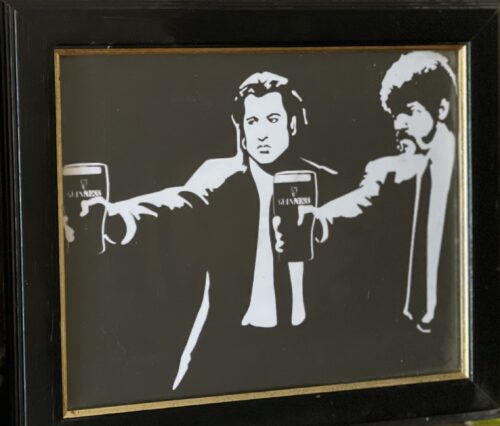 55cm x 45cm Luke Kelly (17 November 1940 – 30 January 1984) was an Irish singer, folk musician and actor from Dublin, Ireland. Born into a working-class household in Dublin city, Kelly moved to England in his late teens and by his early 20s had become involved in a folk music revival. Returning to Dublin in the 1960s, he is noted as a founding member of the band The Dubliners in 1962. Becoming known for his distinctive singing style, and sometimes political messages, the Irish Postand other commentators have regarded Kelly as one of Ireland's greatest folk singers. Early life Luke Kelly was born into a working-class family in Lattimore Cottages at 1 Sheriff Street.His maternal grandmother, who was a MacDonald from Scotland, lived with the family until her death in 1953. His father who was Irish- also named Luke- was shot and severely wounded as a child by British soldiers from the King's Own Scottish Borderers during the 1914 Bachelor's Walk massacre.His father worked all his life in Jacob's biscuit factory and enjoyed playing football. The elder Luke was a keen singer: Luke junior's brother Paddy later recalled that "he had this talent... to sing negro spirituals by people like Paul Robeson, we used to sit around and join in — that was our entertainment". After Dublin Corporation demolished Lattimore Cottages in 1942, the Kellys became the first family to move into the St. Laurence O’Toole flats, where Luke spent the bulk of his childhood, although the family were forced to move by a fire in 1953 and settled in the Whitehall area. Both Luke and Paddy played club Gaelic football and soccer as children. Kelly left school at thirteen and after a number of years of odd-jobbing, he went to England in 1958.[6] Working at steel fixing with his brother Paddy on a building site in Wolverhampton, he was apparently sacked after asking for higher pay. He worked a number of odd jobs, including a period as a vacuum cleaner salesman.Describing himself as a beatnik, he travelled Northern England in search of work, summarising his life in this period as "cleaning lavatories, cleaning windows, cleaning railways, but very rarely cleaning my face".
55cm x 45cm Luke Kelly (17 November 1940 – 30 January 1984) was an Irish singer, folk musician and actor from Dublin, Ireland. Born into a working-class household in Dublin city, Kelly moved to England in his late teens and by his early 20s had become involved in a folk music revival. Returning to Dublin in the 1960s, he is noted as a founding member of the band The Dubliners in 1962. Becoming known for his distinctive singing style, and sometimes political messages, the Irish Postand other commentators have regarded Kelly as one of Ireland's greatest folk singers. Early life Luke Kelly was born into a working-class family in Lattimore Cottages at 1 Sheriff Street.His maternal grandmother, who was a MacDonald from Scotland, lived with the family until her death in 1953. His father who was Irish- also named Luke- was shot and severely wounded as a child by British soldiers from the King's Own Scottish Borderers during the 1914 Bachelor's Walk massacre.His father worked all his life in Jacob's biscuit factory and enjoyed playing football. The elder Luke was a keen singer: Luke junior's brother Paddy later recalled that "he had this talent... to sing negro spirituals by people like Paul Robeson, we used to sit around and join in — that was our entertainment". After Dublin Corporation demolished Lattimore Cottages in 1942, the Kellys became the first family to move into the St. Laurence O’Toole flats, where Luke spent the bulk of his childhood, although the family were forced to move by a fire in 1953 and settled in the Whitehall area. Both Luke and Paddy played club Gaelic football and soccer as children. Kelly left school at thirteen and after a number of years of odd-jobbing, he went to England in 1958.[6] Working at steel fixing with his brother Paddy on a building site in Wolverhampton, he was apparently sacked after asking for higher pay. He worked a number of odd jobs, including a period as a vacuum cleaner salesman.Describing himself as a beatnik, he travelled Northern England in search of work, summarising his life in this period as "cleaning lavatories, cleaning windows, cleaning railways, but very rarely cleaning my face".Musical beginnings
Kelly had been interested in music during his teenage years: he regularly attended céilithe with his sister Mona and listened to American vocalists including: Fats Domino, Al Jolson, Frank Sinatra and Perry Como. He also had an interest in theatre and musicals, being involved with the staging of plays by Dublin's Marian Arts Society. The first folk club he came across was in the Bridge Hotel, Newcastle upon Tyne in early 1960.Having already acquired the use of a banjo, he started memorising songs. In Leeds he brought his banjo to sessions in McReady's pub. The folk revival was under way in England: at the centre of it was Ewan MacColl who scripted a radio programme called Ballads and Blues. A revival in the skiffle genre also injected a certain energy into folk singing at the time. Kelly started busking. On a trip home he went to a fleadh cheoil in Milltown Malbay on the advice of Johnny Moynihan. He listened to recordings of Woody Guthrie and Pete Seeger. He also developed his political convictions which, as Ronnie Drew pointed out after his death, he stuck to throughout his life. As Drew also pointed out, he "learned to sing with perfect diction". Kelly befriended Sean Mulready in Birmingham and lived in his home for a period.Mulready was a teacher who was forced from his job in Dublin because of his communist beliefs. Mulready had strong music links; a sister, Kathleen Moynihan was a founder member of Comhaltas Ceoltóirí Éireann, and he was related by marriage to Festy Conlon, the County Galway whistle player. Mulready's brother-in-law, Ned Stapleton, taught Kelly "The Rocky Road to Dublin".During this period he studied literature and politics under the tutelage of Mulready, his wife Mollie, and Marxist classicist George Derwent Thomson: Kelly later stated that his interest in music grew parallel to his interest in politics. Kelly bought his first banjo, which had five strings and a long neck, and played it in the style of Pete Seeger and Tommy Makem. At the same time, Kelly began a habit of reading, and also began playing golf on one of Birmingham's municipal courses. He got involved in the Jug O'Punch folk club run by Ian Campbell. He befriended Dominic Behan and they performed in folk clubs and Irish pubs from London to Glasgow. In London pubs, like "The Favourite", he would hear street singer Margaret Barry and musicians in exile like Roger Sherlock, Seamus Ennis, Bobby Casey and Mairtín Byrnes. Luke Kelly was by now active in the Connolly Association, a left-wing grouping strongest among the emigres in England, and he also joined the Young Communist League: he toured Irish pubs playing his set and selling the Connolly Association's newspaper The Irish Democrat. By 1962 George Derwent Thomson had offered him the opportunity to further his educational and political development by attending university in Prague. However, Kelly turned down the offer in favour of pursuing his career in folk music. He was also to start frequenting Ewan MacColl and Peggy Seeger's Singer Club in London.The Dubliners
In 1961 there was a folk music revival or "ballad boom", as it was later termed, in waiting in Ireland.The Abbey Tavern sessions in Howth were the forerunner to sessions in the Hollybrook, Clontarf, the International Bar and the Grafton Cinema. Luke Kelly returned to Dublin in 1962. O'Donoghue's Pub was already established as a session house and soon Kelly was singing with, among others, Ronnie Drew and Barney McKenna. Other early people playing at O'Donoghues included The Fureys, father and sons, John Keenan and Sean Og McKenna, Johnny Moynihan, Andy Irvine, Seamus Ennis, Willy Clancy and Mairtin Byrnes. A concert John Molloy organised in the Hibernian Hotel led to his "Ballad Tour of Ireland" with the Ronnie Drew Ballad Group (billed in one town as the Ronnie Drew Ballet Group). This tour led to the Abbey Tavern and the Royal Marine Hotel and then to jam-packed sessions in the Embankment, Tallaght. Ciarán Bourke joined the group, followed later by John Sheahan. They renamed themselves The Dubliners at Kelly's suggestion, as he was reading James Joyce's book of short stories, entitled Dubliners, at the time.Kelly was the leading vocalist for the group's eponymous debut album in 1964, which included his rendition of "The Rocky Road to Dublin". Barney McKenna later noted that Kelly was the only singer he'd heard sing it to the rhythm it was played on the fiddle. In 1964 Luke Kelly left the group for nearly two years and was replaced by Bobby Lynch and John Sheahan. Kelly went with Deirdre O'Connell, founder of the Focus Theatre, whom he was to marry the following year, back to London and became involved in Ewan MacColl's "gathering". The Critics, as it was called, was formed to explore folk traditions and help young singers. During this period he retained his political commitments, becoming increasingly active in the Campaign for Nuclear Disarmament. Kelly also met and befriended Michael O'Riordan, the General Secretary of the Irish Workers' Party, and the two developed a "personal-political friendship". Kelly endorsed O'Riordan for election, and held a rally in his name during campaigning in 1965.In 1965, he sang 'The Rocky Road to Dublin' with Liam Clancy on his first, self-titled solo album. Bobby Lynch left The Dubliners, John Sheahan and Kelly rejoined. They recorded an album in the Gate Theatre, Dublin, played the Cambridge Folk Festival and recorded Irish Night Out, a live album with, among others, exiles Margaret Barry, Michael Gorman and Jimmy Powers. They also played a concert in the National Stadium in Dublin with Pete Seeger as special guest. They were on the road to success: Top Twenty hits with "Seven Drunken Nights" and "The Black Velvet Band", The Ed Sullivan Show in 1968 and a tour of New Zealand and Australia. The ballad boom in Ireland was becoming increasingly commercialised with bar and pub owners building ever larger venues for pay-in performances. Ewan MacColl and Peggy Seeger on a visit to Dublin expressed concern to Kelly about his drinking.[citation needed] Christy Moore and Kelly became acquainted in the 1960s.During his Planxty days, Moore got to know Kelly well. In 1972 The Dubliners themselves performed in Richard's Cork Leg, based on the "incomplete works" of Brendan Behan. In 1973, Kelly took to the stage performing as King Herod in Jesus Christ Superstar. The arrival of a new manager for The Dubliners, Derry composer Phil Coulter, resulted in a collaboration that produced three of Kelly's most notable performances: “The Town I Loved So Well”, "Hand me Down my Bible", and “Scorn Not His Simplicity”, a song about Phil's son who had Down Syndrome.Kelly had such respect for the latter song that he only performed it once for a television recording and rarely, if ever, sang it at the Dubliners' often boisterous events. His interpretations of “On Raglan Road” and "Scorn Not His Simplicity" became significant points of reference in Irish folk music.His version of "Raglan Road" came about when the poem's author, Patrick Kavanagh, heard him singing in a Dublin pub, and approached Kelly to say that he should sing the poem (which is set to the tune of “The Dawning of the Day”). Kelly remained a politically engaged musician, becoming a supporter of the movement against South African apartheid and performing at benefit concerts for the Irish Traveller community,and many of the songs he recorded dealt with social issues, the arms race and the Cold War, trade unionism and Irish republicanism, ("The Springhill Disaster", "Joe Hill", "The Button Pusher", "Alabama 1958" and "God Save Ireland" all being examples of his concerns).Personal life
Luke Kelly married Deirdre O'Connell in 1965, but they separated in the early 1970s.Kelly spent the last eight years of his life living with his partner Madeleine Seiler, who is from Germany.Final years
Kelly's health deteriorated in the 1970s. Kelly himself spoke about his problems with alcohol. On 30 June 1980 during a concert in the Cork Opera House he collapsed on the stage. He had already suffered for some time from migraines and forgetfulness - including forgetting what country he was in whilst visiting Iceland - which had been ascribed to his intense schedule, alcohol consumption, and "party lifestyle". A brain tumour was diagnosed.Although Kelly toured with the Dubliners after enduring an operation, his health deteriorated further. He forgot lyrics and had to take longer breaks in concerts as he felt weak. In addition following his emergency surgery after his collapse in Cork, he became more withdrawn, preferring the company of Madeleine at home to performing.On his European tour he managed to perform with the band for most of the show in Carre for their Live in Carre album. However, in autumn 1983 he had to leave the stage in Traun, Austria and again in Mannheim, Germany. Shortly after this, he had to cancel the tour of southern Germany, and after a short stay in hospital in Heidelberg he was flown back to Dublin. After another operation he spent Christmas with his family but was taken into hospital again in the New Year, where he died on 30 January 1984.Kelly's funeral in Whitehall attracted thousands of mourners from across Ireland.His gravestone in Glasnevin Cemetery, Dublin, bears the inscription: Luke Kelly – Dubliner. Sean Cannon took Kelly's place in The Dubliners. He had been performing with the Dubliners since 1982,due to the deterioration of Kelly's health.Legacy
Luke Kelly's legacy and contributions to Irish music and culture have been described as "iconic" and have been captured in a number of documentaries and anthologies. The influence of his Scottish grandmother was influential in Kelly's help in preserving important traditional Scottish songs such as "Mormond Braes", the Canadian folk song "Peggy Gordon", "Robert Burns", "Parcel of Rogues", "Tibbie Dunbar", Hamish Henderson's "Freedom Come-All-Ye", and Thurso Berwick's "Scottish Breakaway". The Ballybough Bridge in the north inner city of Dublin was renamed the Luke Kelly Bridge, and in November 2004 Dublin City Council voted unanimously to erect a bronze statue of Luke Kelly. However, the Dublin Docklands Authority subsequently stated that it could no longer afford to fund the statue. In 2010, councillor Christy Burke of Dublin City Council appealed to members of the music community including Bono, Phil Coulter and Enya to help build it. Paddy Reilly recorded a tribute to Kelly entitled "The Dublin Minstrel". It featured on his Gold And Silver Years, Celtic Collections and the Essential Paddy Reilly CD's. The Dubliners recorded the song on their Live at Vicar Street DVD/CD. The song was composed by Declan O'Donoghue, the Racing Correspondent of The Irish Sun. At Christmas 2005 writer-director Michael Feeney Callan's documentary, Luke Kelly: The Performer, was released and outsold U2's latest DVD during the festive season and into 2006, acquiring platinum sales status. The documentary told Kelly's story through the words of the Dubliners, Donovan, Ralph McTell and others and featured full versions of rarely seen performances such as the early sixties' Ed Sullivan Show. A later documentary, Luke Kelly: Prince of the City, was also well received. Two statues of Kelly were unveiled in Dublin in January 2019, to mark the 35th anniversary of his death.One, a life-size seated bronze by John Coll, is on South King Street. The second sculpture, a marble portrait head by Vera Klute, is on Sheriff Street. The Klute sculpture was vandalised on several occasions in 2019 and 2020, in each case being restored by graffiti-removal specialists.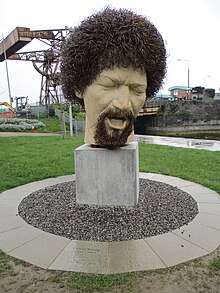 Sculpture of Luke Kelly on Sheriff Street by Vera Klute. Unveiled in 2019
Sculpture of Luke Kelly on Sheriff Street by Vera Klute. Unveiled in 2019 -
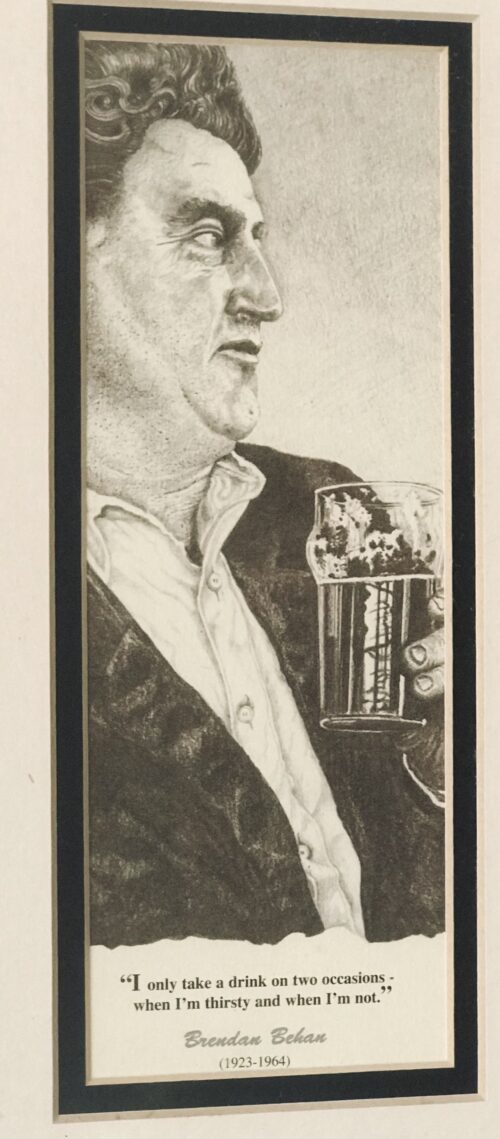
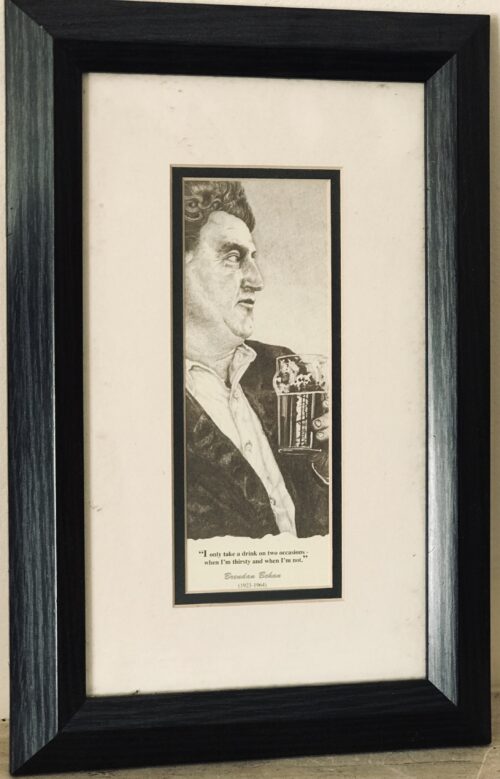 Humorous sketch of the enigmatic genius Brendan Began with typical irreverent quote attached. 37.5cm x 25.5cm Dublin BRENDAN BEHAN 1923-1964 PLAYWRIGHT AND AUTHOR Behan was born in Dublin on 9 February 1923. His father was a house painter who had been imprisoned as a republican towards the end of the Civil War, and from an early age Behan was steeped in Irish history and patriotic ballads; however, there was also a strong literary and cultural atmosphere in his home. At fourteen Behan was apprenticed to his father's trade. He was already a member of Fianna Éireann, the youth organisation of the Irish Republican Army, and a contributor to The United Irishman. When the IRA launched a bombing campaign in England in 1939, Behan was trained in explosives, but was arrested the day he landed in Liverpool. In February 1940 he was sentenced to three years' Borstal detention. He spent two years in a Borstal in Suffolk, making good use of its excellent library. In 1942, back in Dublin, Behan fired at a detective during an IRA parade and was sentenced to fourteen years' penal servitude. Again he broadened his education, becoming a fluent Irish speaker. During his first months in Mountjoy prison, Sean O Faolain published Behan's description of his Borstal experiences in The Bell. Behan was released in 1946 as part of a general amnesty and returned to painting. He would serve other prison terms, either for republican activity or as a result of his drinking, but none of such length. For some years Behan concentrated on writing verse in Irish. He lived in Paris for a time before returning in 1950 to Dublin, where he cultivated his reputation as one of the more rambunctious figures in the city's literary circles. In 1954 Behan's play The Quare Fellow was well received in the tiny Pike Theatre. However, it was the 1956 production at Joan Littlewood's Theatre Royal in Stratford, East London, that brought Behan a wider reputation - significantly assisted by a drunken interview on BBC television. Thereafter, Behan was never free from media attention, and he in turn was usually ready to play the drunken Irlshman. The 'quare fellow', never seen on stage, is a condemned man in prison. His imminent execution touches the lives of the other prisoners, the warders and the hangman, and the play is in part a protest against capital punishment. More important, though, its blend of tragedy and comedy underlines the survival of the prisoners' humanity in their inhumane environment. How much the broader London version owed to Joan Littlewood is a matter of debate. Comparing him with another alcoholic writer, Dylan Thomas, a friend said that 'Dylan wrote Under Milkwood and Brendan wrote under Littlewood'. Behan's second play, An Giall (1958), was commissioned by Gael Linn, the Irish-language organisation. Behan translated the play into English and it was Joan Littlewood's production of The Hostage (1958) which led to success in London and New York. As before Behan's tragi-comedy deals with a closed world, in this case a Dublin brothel where the IRA imprison an English soldier, but Littlewood diluted the naturalism of the Irish version with interludes of music-hall singing and dancing. Behan's autobiographical Borstal Boy also appeared in 1958, and its early chapters on prison life are among his best work. By then, however, he was a victim of his own celebrity, and alcoholism and diabetes were taking their toll. His English publishers suggested that, instead of the writing he now found difficult, he dictate to a tape recorder. The first outcome was Brendan Behan's Island (1962), a readable collection of anecdotes and opinions in which it was apparent that Behan had moved away from the republican extremism of his youth. Tape-recording also produced Brendan Behan's New York(1964) and Confessions of an Irish Rebel (1965), a disappointing sequel to Borstal Boy. A collection of newspaper columns from the l950s, published as Hold Your Hour and Have Another (1963), merely underlined the inferiority of his later work. When Behan died in Dublin on 20 March 1964, an IRA guard of honour escorted his coffin. One newspaper described it as the biggest funeral since those of Michael Collins and Charles Stewart Parnell.
Humorous sketch of the enigmatic genius Brendan Began with typical irreverent quote attached. 37.5cm x 25.5cm Dublin BRENDAN BEHAN 1923-1964 PLAYWRIGHT AND AUTHOR Behan was born in Dublin on 9 February 1923. His father was a house painter who had been imprisoned as a republican towards the end of the Civil War, and from an early age Behan was steeped in Irish history and patriotic ballads; however, there was also a strong literary and cultural atmosphere in his home. At fourteen Behan was apprenticed to his father's trade. He was already a member of Fianna Éireann, the youth organisation of the Irish Republican Army, and a contributor to The United Irishman. When the IRA launched a bombing campaign in England in 1939, Behan was trained in explosives, but was arrested the day he landed in Liverpool. In February 1940 he was sentenced to three years' Borstal detention. He spent two years in a Borstal in Suffolk, making good use of its excellent library. In 1942, back in Dublin, Behan fired at a detective during an IRA parade and was sentenced to fourteen years' penal servitude. Again he broadened his education, becoming a fluent Irish speaker. During his first months in Mountjoy prison, Sean O Faolain published Behan's description of his Borstal experiences in The Bell. Behan was released in 1946 as part of a general amnesty and returned to painting. He would serve other prison terms, either for republican activity or as a result of his drinking, but none of such length. For some years Behan concentrated on writing verse in Irish. He lived in Paris for a time before returning in 1950 to Dublin, where he cultivated his reputation as one of the more rambunctious figures in the city's literary circles. In 1954 Behan's play The Quare Fellow was well received in the tiny Pike Theatre. However, it was the 1956 production at Joan Littlewood's Theatre Royal in Stratford, East London, that brought Behan a wider reputation - significantly assisted by a drunken interview on BBC television. Thereafter, Behan was never free from media attention, and he in turn was usually ready to play the drunken Irlshman. The 'quare fellow', never seen on stage, is a condemned man in prison. His imminent execution touches the lives of the other prisoners, the warders and the hangman, and the play is in part a protest against capital punishment. More important, though, its blend of tragedy and comedy underlines the survival of the prisoners' humanity in their inhumane environment. How much the broader London version owed to Joan Littlewood is a matter of debate. Comparing him with another alcoholic writer, Dylan Thomas, a friend said that 'Dylan wrote Under Milkwood and Brendan wrote under Littlewood'. Behan's second play, An Giall (1958), was commissioned by Gael Linn, the Irish-language organisation. Behan translated the play into English and it was Joan Littlewood's production of The Hostage (1958) which led to success in London and New York. As before Behan's tragi-comedy deals with a closed world, in this case a Dublin brothel where the IRA imprison an English soldier, but Littlewood diluted the naturalism of the Irish version with interludes of music-hall singing and dancing. Behan's autobiographical Borstal Boy also appeared in 1958, and its early chapters on prison life are among his best work. By then, however, he was a victim of his own celebrity, and alcoholism and diabetes were taking their toll. His English publishers suggested that, instead of the writing he now found difficult, he dictate to a tape recorder. The first outcome was Brendan Behan's Island (1962), a readable collection of anecdotes and opinions in which it was apparent that Behan had moved away from the republican extremism of his youth. Tape-recording also produced Brendan Behan's New York(1964) and Confessions of an Irish Rebel (1965), a disappointing sequel to Borstal Boy. A collection of newspaper columns from the l950s, published as Hold Your Hour and Have Another (1963), merely underlined the inferiority of his later work. When Behan died in Dublin on 20 March 1964, an IRA guard of honour escorted his coffin. One newspaper described it as the biggest funeral since those of Michael Collins and Charles Stewart Parnell. -
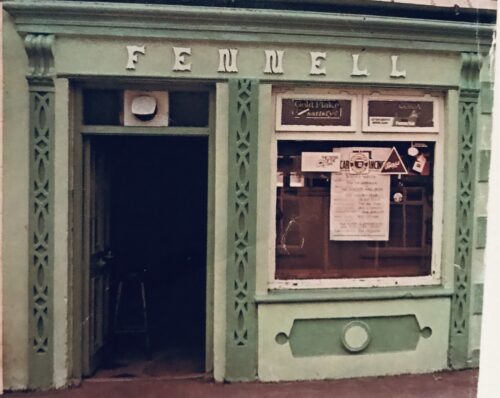
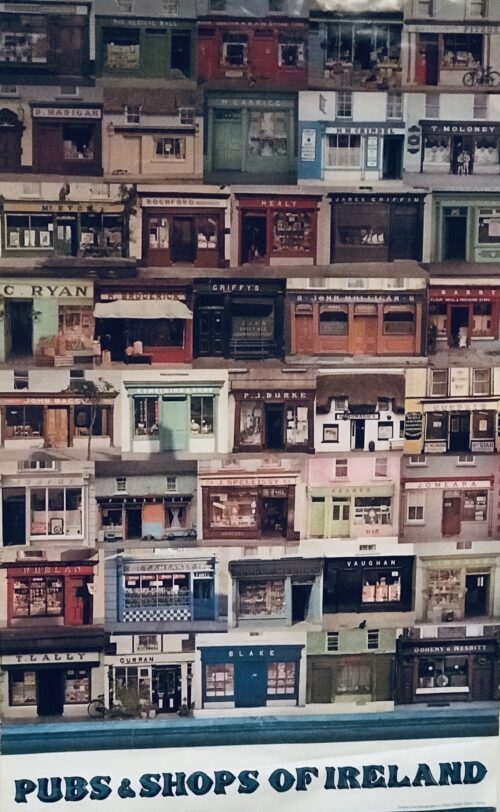 88cm x 52cm In olden times the traditional Irish country pub also often functioned as a grocery,sweetshop,veterinary chemist,hardware store and haberdashery where patrons could partake in a soothing drink after shopping alongside displays of chocolate bars, tins of canned fruit, reels of hay bailer twine, and tubs of sheep dip.Sadly grocery bars are now few and far between but the ones that survive are a throwback to an old and innocent way of life.Dingle in Co Kerry is home to many of the best surviving examples of the pub-grocer.In the famous Currans on Main Street ,the pub always doubled as a general merchant.They sold everything and supplied the townspeople and farmers who would pile into the town on Fairday.The old ledgers still in existence are stuffed with billheads from all types of suppliers- everything was sold -ropes.twines,seeds,ales,buckets,hams,jams,fishing nets,flowers,ladies rubber heels and tights, cloth caps, shirts,boots- the list is endless.
88cm x 52cm In olden times the traditional Irish country pub also often functioned as a grocery,sweetshop,veterinary chemist,hardware store and haberdashery where patrons could partake in a soothing drink after shopping alongside displays of chocolate bars, tins of canned fruit, reels of hay bailer twine, and tubs of sheep dip.Sadly grocery bars are now few and far between but the ones that survive are a throwback to an old and innocent way of life.Dingle in Co Kerry is home to many of the best surviving examples of the pub-grocer.In the famous Currans on Main Street ,the pub always doubled as a general merchant.They sold everything and supplied the townspeople and farmers who would pile into the town on Fairday.The old ledgers still in existence are stuffed with billheads from all types of suppliers- everything was sold -ropes.twines,seeds,ales,buckets,hams,jams,fishing nets,flowers,ladies rubber heels and tights, cloth caps, shirts,boots- the list is endless. -
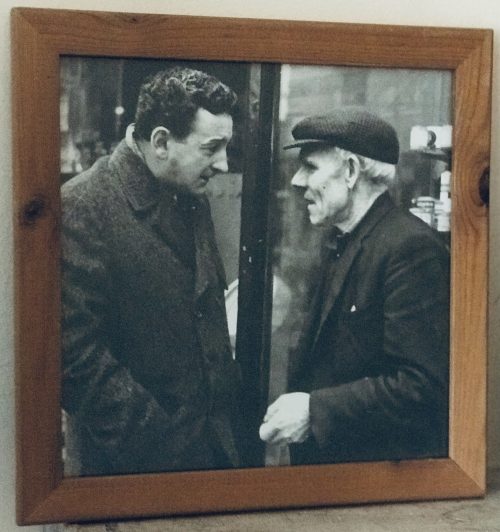 Fantastic photo of the late, great John B Keane having an in depth conversation with an old neighbour or friend in north Kerry or West Limerick. Abbeyfeale Co Limerick 24cm x 21cm
Fantastic photo of the late, great John B Keane having an in depth conversation with an old neighbour or friend in north Kerry or West Limerick. Abbeyfeale Co Limerick 24cm x 21cm
John Brendan Keane (21 July 1928 – 30 May 2002) was an Irish playwright, novelist and essayist from Listowel, County Kerry.John B. Keane Statue of John B. Keane in Listowel, County Kerry.
Statue of John B. Keane in Listowel, County Kerry.Born John Brendan Keane 21 July 1928 Church Street, Listowel, County Kerry, Ireland Died 30 May 2002 (aged 73) Listowel, County Kerry, Ireland Nationality Irish Education St Michael's College, Listowel Notable works The Field, Sive Notable awards Honorary Life Member of the Royal Dublin Society Spouse Mary O'Connor Children Billy Keane Conor Keane John Keane Joanna Keane Biography
A son of a national school teacher, William B. Keane, and his wife Hannah (née Purtill), Keane was educated at Listowel National School and then at St Michael's College, Listowel. He worked as a chemist's assistant for A.H. Jones who dabbled in buying antiques. Keane had various jobs in the UK between 1951 and 1955 working as a street cleaner, and a bar man, living in a variety of places including Northampton and London. It was while he was in Northampton that Keane was first published in an unnamed women's magazine for which he received £15. After returning from the United Kingdom, he was a pub owner in Listowel from 1955. He married Mary O'Connor at Knocknagoshel Church on 5 January 1955 and had four children: Billy, Conor, John and Joanna. He was an Honorary Life Member of the Royal Dublin Society from 1991, served as president of Irish PEN and was a founder member of the Society of Irish Playwrights as well as a member of Aosdána. Keane was named the patron of the Listowel Players after the Listowel Drama Group fractured.He remained a prominent member of the Fine Gael party throughout his life, never being shy of political debate. His nephew is the investigative journalist Fergal Keane. His son John is a journalist with the Kilkenny People while his son, Billy regularly writes a column for the Irish Independent.Influences
Keane cited many literary influences including Bryan MacMahon and George Fitzmaurice, fellow Kerry writers and playwrights. His personal influences were numerous but, most notably he thanked his father and his wife, Mary. Keane was grateful for his father's help with early editing, allowed him access to his personal library, and encouraged him to continue his work until he was successful. He was also influenced by the local population and the patrons of his pub, on whom he based some of his characters. -
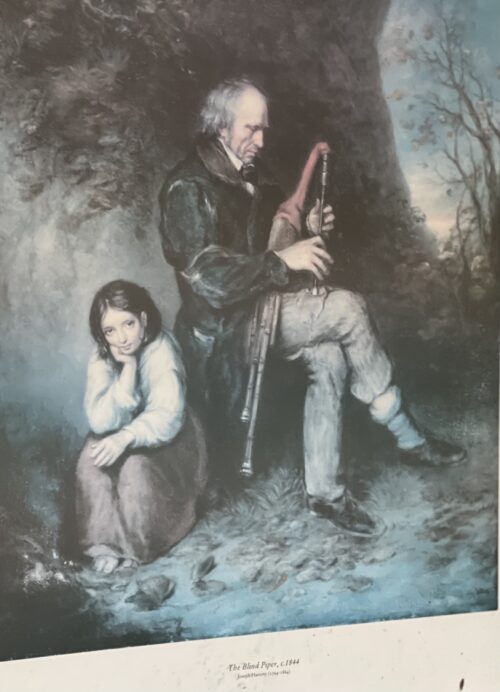
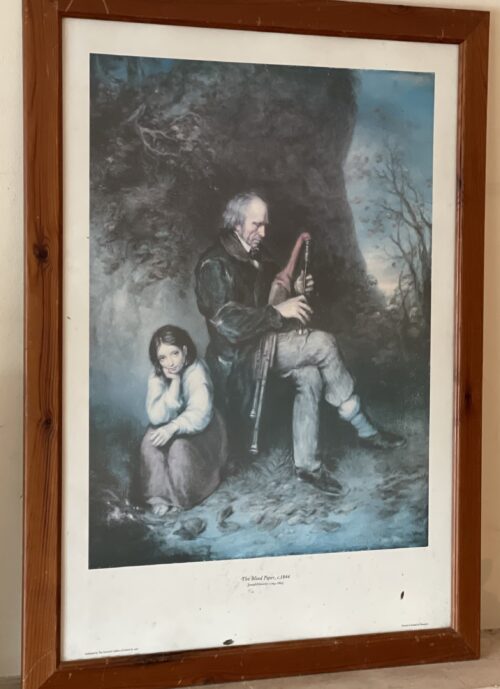
This painting of Clare piper Pádraig Ó Briain by the artist Joseph Haverty was hugely popular in 19th-century Ireland.
82cm x 58cm. LimerickAn oil painting of a street musician who played regularly in Limerick city, was painted in oil on canvas. The subject, uileann piper Pádraig Ó Briain (there are several variant spellings of his name on record), occupied a space on the corner of the Crescent and Hartstonge Street in Limerick and presumably Haverty noticed him there. Pipers were esteemed in Ireland and were a popular subject. Haverty had a sound instinct for what would appeal to an audience. He transposed the piper from an urban to a woodland setting, which is theatrical but effective, and the painting seems to have been known under several different titles, including The Father and Daughter (O’Brien had two daughters but opinions differ as to whether the girl depicted was one of them), The Blind Piper and The Irish Piper.
Reproduced as a print under the title The Limerick Piper, it sold widely throughout the country and became extremely well-known. Haverty made another quite different painting of the piper, now in the University of Limerick collection, but he also made copies of his own work.
To complicate things slightly: The Blind Piper was exhibited by the RHA in 1845, when it was praised in the Nation. It was perhaps this version that Sir Josslyn Gore-Booth bought and exhibited at the Cork exhibition in 1852. But there were other versions in circulation. Young Irelander William Smith O’Brien reputedly commissioned a copy from Haverty, and bequeathed it to the National Gallery of Ireland in 1864.
The Blind Piper is included in the exhibition Oidhreacht: Transforming Tradition at the Highlanes Gallery, Laurence Street, Drogheda, Co Louth (July 13th – September 14th), timed to coincide with Fleadh Cheoil na hÉireann which takes place July 10th-18th in Drogheda.
The annual week-long festival, a lively mix of summer school, competition and a packed programme of traditional music concerts attracts up to 500,000 people from throughout Ireland North and South, the UK and internationally. The exhibition of art and artefacts is drawn from Drogheda’s Municipal Art Collection as well as those of major public museums, including the National Gallery of Ireland and Imma. It aims to explore “the rich social, political and aesthetic contexts in which the traditional arts have been expressed”.
-
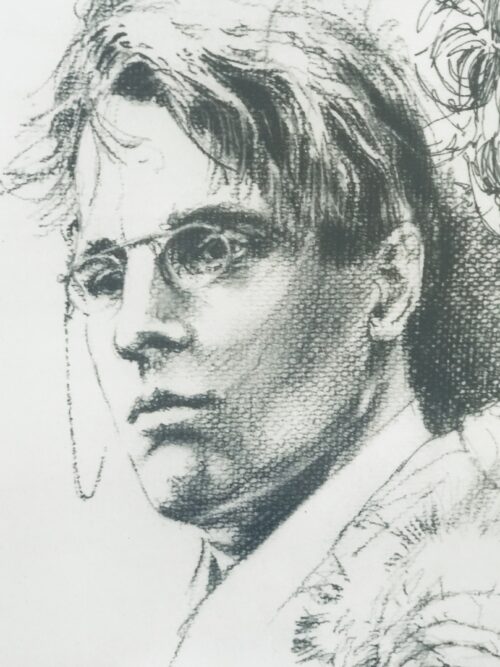
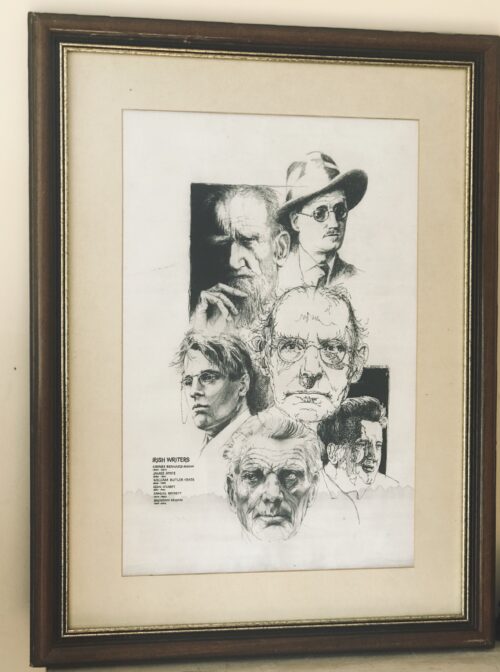 Striking and large print of a drawing on charcoal depicting five Irish Literary behemoths-James Joyce,W.B Yeats ,Samuel Beckett,Brendan Behan & Sean O'Casey.There is some slight water staining on the bottom of the front as this was stored in the basement of a long closed Dublin pub but now gladly resurrected and reframed. Dublin 90cm x 68cm
Striking and large print of a drawing on charcoal depicting five Irish Literary behemoths-James Joyce,W.B Yeats ,Samuel Beckett,Brendan Behan & Sean O'Casey.There is some slight water staining on the bottom of the front as this was stored in the basement of a long closed Dublin pub but now gladly resurrected and reframed. Dublin 90cm x 68cm -
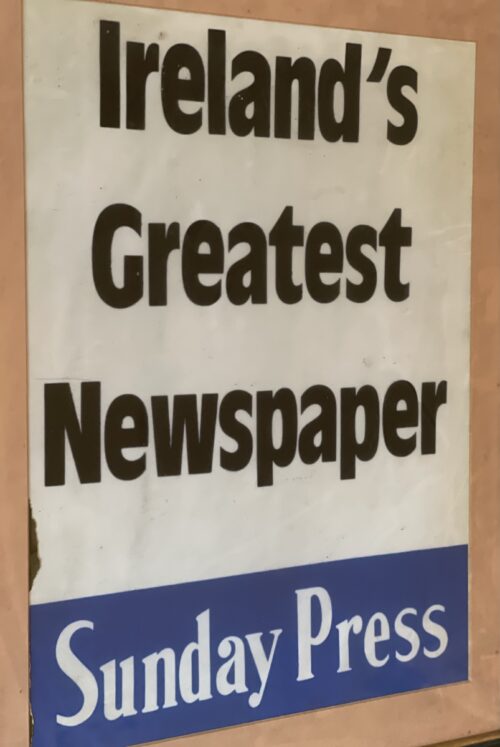
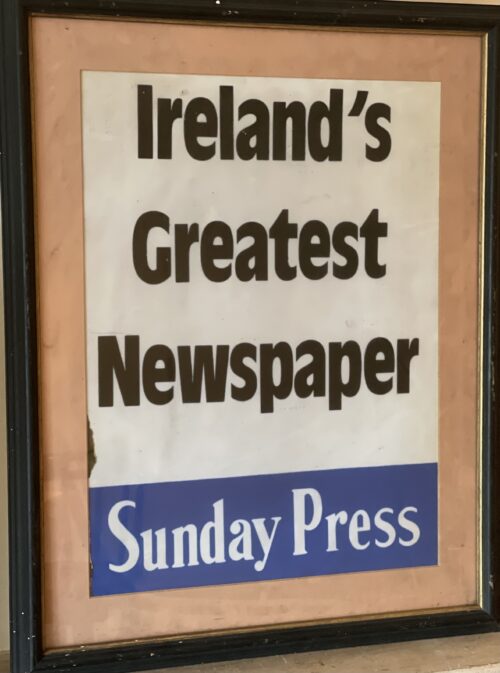 67cm x 54cm Dublin The Sunday Press was a weekly newspaper published in Ireland from 1949 until 1995. It was launched by Éamon de Valera's Irish Press group following the defeat of his Fianna Fáil party in the 1948 Irish general election. Like its sister newspaper, the daily The Irish Press, politically the paper loyally supported Fianna Fáil. The future Taoiseach Seán Lemass was the managing editor of the Irish Press who spearheaded the launch of the Sunday paper, with the first editor Colonel Matt Feehan. Many of the Irish Press journalists contributed to the paper. 'When I open the pages, I duck' was Brendan Behan's description of reading The Sunday Press, for the habit of published memoirs of veterans (usually those aligned to Fianna Fáil) of the Irish War of Independence. It soon built up a large readership, and overtook its main competitor the Sunday Independent, which tended to support Fine Gael. At its peak The Sunday Press sold up to 475,000 copies every week, and had a readership of over one million, around one third of the Irish population. Like the Evening Press, the paper's readership held up better over the years than that of the flagship title in the group, The Irish Press, and it might have survived as a stand-alone title had it been sold. However, with the collapse of the Irish Press Newspapers group in May 1995, all three titles ceased publication immediately. The launch of Ireland on Sunday in 1997 was initially interpreted by many observers as an attempt to appeal to the former readership of The Sunday Press, seen as generally rural, fairly conservative Catholic, and with a traditional Irish nationalist political outlook. When Christmas Day fell on Sunday in 1949, 1955, 1960, 1966, 1977, 1983, 1988 and 1994 the paper came out on the Saturday. Vincent Jennings at the age of 31 became editor of The Sunday Press in 1968, serving until December 1986, when he became manager of the Irish Press Group. Journalists who worked at the press include Stephen Collins served as political editor his father Willie Collins was deputy editorand Michael Carwood became sports editor of The Sunday Press in 1988[5] until its closure in 1995.
67cm x 54cm Dublin The Sunday Press was a weekly newspaper published in Ireland from 1949 until 1995. It was launched by Éamon de Valera's Irish Press group following the defeat of his Fianna Fáil party in the 1948 Irish general election. Like its sister newspaper, the daily The Irish Press, politically the paper loyally supported Fianna Fáil. The future Taoiseach Seán Lemass was the managing editor of the Irish Press who spearheaded the launch of the Sunday paper, with the first editor Colonel Matt Feehan. Many of the Irish Press journalists contributed to the paper. 'When I open the pages, I duck' was Brendan Behan's description of reading The Sunday Press, for the habit of published memoirs of veterans (usually those aligned to Fianna Fáil) of the Irish War of Independence. It soon built up a large readership, and overtook its main competitor the Sunday Independent, which tended to support Fine Gael. At its peak The Sunday Press sold up to 475,000 copies every week, and had a readership of over one million, around one third of the Irish population. Like the Evening Press, the paper's readership held up better over the years than that of the flagship title in the group, The Irish Press, and it might have survived as a stand-alone title had it been sold. However, with the collapse of the Irish Press Newspapers group in May 1995, all three titles ceased publication immediately. The launch of Ireland on Sunday in 1997 was initially interpreted by many observers as an attempt to appeal to the former readership of The Sunday Press, seen as generally rural, fairly conservative Catholic, and with a traditional Irish nationalist political outlook. When Christmas Day fell on Sunday in 1949, 1955, 1960, 1966, 1977, 1983, 1988 and 1994 the paper came out on the Saturday. Vincent Jennings at the age of 31 became editor of The Sunday Press in 1968, serving until December 1986, when he became manager of the Irish Press Group. Journalists who worked at the press include Stephen Collins served as political editor his father Willie Collins was deputy editorand Michael Carwood became sports editor of The Sunday Press in 1988[5] until its closure in 1995. -
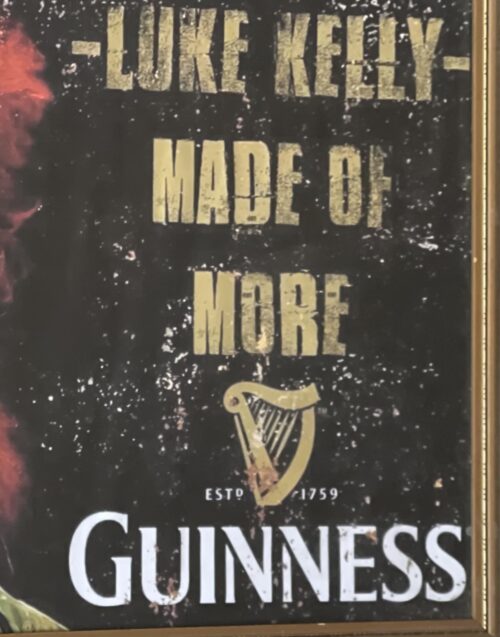
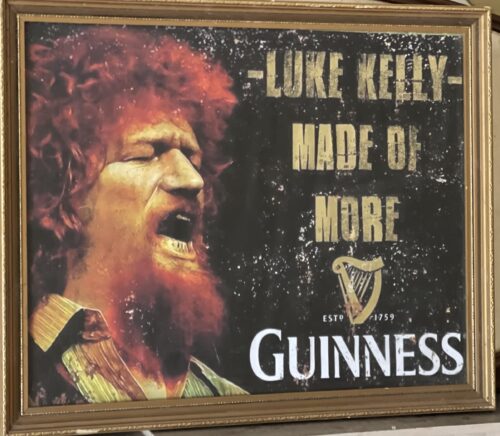 55cm x 45cm Luke Kelly (17 November 1940 – 30 January 1984) was an Irish singer, folk musician and actor from Dublin, Ireland. Born into a working-class household in Dublin city, Kelly moved to England in his late teens and by his early 20s had become involved in a folk music revival. Returning to Dublin in the 1960s, he is noted as a founding member of the band The Dubliners in 1962. Becoming known for his distinctive singing style, and sometimes political messages, the Irish Postand other commentators have regarded Kelly as one of Ireland's greatest folk singers. Early life Luke Kelly was born into a working-class family in Lattimore Cottages at 1 Sheriff Street.His maternal grandmother, who was a MacDonald from Scotland, lived with the family until her death in 1953. His father who was Irish- also named Luke- was shot and severely wounded as a child by British soldiers from the King's Own Scottish Borderers during the 1914 Bachelor's Walk massacre.His father worked all his life in Jacob's biscuit factory and enjoyed playing football. The elder Luke was a keen singer: Luke junior's brother Paddy later recalled that "he had this talent... to sing negro spirituals by people like Paul Robeson, we used to sit around and join in — that was our entertainment". After Dublin Corporation demolished Lattimore Cottages in 1942, the Kellys became the first family to move into the St. Laurence O’Toole flats, where Luke spent the bulk of his childhood, although the family were forced to move by a fire in 1953 and settled in the Whitehall area. Both Luke and Paddy played club Gaelic football and soccer as children. Kelly left school at thirteen and after a number of years of odd-jobbing, he went to England in 1958.[6] Working at steel fixing with his brother Paddy on a building site in Wolverhampton, he was apparently sacked after asking for higher pay. He worked a number of odd jobs, including a period as a vacuum cleaner salesman.Describing himself as a beatnik, he travelled Northern England in search of work, summarising his life in this period as "cleaning lavatories, cleaning windows, cleaning railways, but very rarely cleaning my face".
55cm x 45cm Luke Kelly (17 November 1940 – 30 January 1984) was an Irish singer, folk musician and actor from Dublin, Ireland. Born into a working-class household in Dublin city, Kelly moved to England in his late teens and by his early 20s had become involved in a folk music revival. Returning to Dublin in the 1960s, he is noted as a founding member of the band The Dubliners in 1962. Becoming known for his distinctive singing style, and sometimes political messages, the Irish Postand other commentators have regarded Kelly as one of Ireland's greatest folk singers. Early life Luke Kelly was born into a working-class family in Lattimore Cottages at 1 Sheriff Street.His maternal grandmother, who was a MacDonald from Scotland, lived with the family until her death in 1953. His father who was Irish- also named Luke- was shot and severely wounded as a child by British soldiers from the King's Own Scottish Borderers during the 1914 Bachelor's Walk massacre.His father worked all his life in Jacob's biscuit factory and enjoyed playing football. The elder Luke was a keen singer: Luke junior's brother Paddy later recalled that "he had this talent... to sing negro spirituals by people like Paul Robeson, we used to sit around and join in — that was our entertainment". After Dublin Corporation demolished Lattimore Cottages in 1942, the Kellys became the first family to move into the St. Laurence O’Toole flats, where Luke spent the bulk of his childhood, although the family were forced to move by a fire in 1953 and settled in the Whitehall area. Both Luke and Paddy played club Gaelic football and soccer as children. Kelly left school at thirteen and after a number of years of odd-jobbing, he went to England in 1958.[6] Working at steel fixing with his brother Paddy on a building site in Wolverhampton, he was apparently sacked after asking for higher pay. He worked a number of odd jobs, including a period as a vacuum cleaner salesman.Describing himself as a beatnik, he travelled Northern England in search of work, summarising his life in this period as "cleaning lavatories, cleaning windows, cleaning railways, but very rarely cleaning my face".Musical beginnings
Kelly had been interested in music during his teenage years: he regularly attended céilithe with his sister Mona and listened to American vocalists including: Fats Domino, Al Jolson, Frank Sinatra and Perry Como. He also had an interest in theatre and musicals, being involved with the staging of plays by Dublin's Marian Arts Society. The first folk club he came across was in the Bridge Hotel, Newcastle upon Tyne in early 1960.Having already acquired the use of a banjo, he started memorising songs. In Leeds he brought his banjo to sessions in McReady's pub. The folk revival was under way in England: at the centre of it was Ewan MacColl who scripted a radio programme called Ballads and Blues. A revival in the skiffle genre also injected a certain energy into folk singing at the time. Kelly started busking. On a trip home he went to a fleadh cheoil in Milltown Malbay on the advice of Johnny Moynihan. He listened to recordings of Woody Guthrie and Pete Seeger. He also developed his political convictions which, as Ronnie Drew pointed out after his death, he stuck to throughout his life. As Drew also pointed out, he "learned to sing with perfect diction". Kelly befriended Sean Mulready in Birmingham and lived in his home for a period.Mulready was a teacher who was forced from his job in Dublin because of his communist beliefs. Mulready had strong music links; a sister, Kathleen Moynihan was a founder member of Comhaltas Ceoltóirí Éireann, and he was related by marriage to Festy Conlon, the County Galway whistle player. Mulready's brother-in-law, Ned Stapleton, taught Kelly "The Rocky Road to Dublin".During this period he studied literature and politics under the tutelage of Mulready, his wife Mollie, and Marxist classicist George Derwent Thomson: Kelly later stated that his interest in music grew parallel to his interest in politics. Kelly bought his first banjo, which had five strings and a long neck, and played it in the style of Pete Seeger and Tommy Makem. At the same time, Kelly began a habit of reading, and also began playing golf on one of Birmingham's municipal courses. He got involved in the Jug O'Punch folk club run by Ian Campbell. He befriended Dominic Behan and they performed in folk clubs and Irish pubs from London to Glasgow. In London pubs, like "The Favourite", he would hear street singer Margaret Barry and musicians in exile like Roger Sherlock, Seamus Ennis, Bobby Casey and Mairtín Byrnes. Luke Kelly was by now active in the Connolly Association, a left-wing grouping strongest among the emigres in England, and he also joined the Young Communist League: he toured Irish pubs playing his set and selling the Connolly Association's newspaper The Irish Democrat. By 1962 George Derwent Thomson had offered him the opportunity to further his educational and political development by attending university in Prague. However, Kelly turned down the offer in favour of pursuing his career in folk music. He was also to start frequenting Ewan MacColl and Peggy Seeger's Singer Club in London.The Dubliners
In 1961 there was a folk music revival or "ballad boom", as it was later termed, in waiting in Ireland.The Abbey Tavern sessions in Howth were the forerunner to sessions in the Hollybrook, Clontarf, the International Bar and the Grafton Cinema. Luke Kelly returned to Dublin in 1962. O'Donoghue's Pub was already established as a session house and soon Kelly was singing with, among others, Ronnie Drew and Barney McKenna. Other early people playing at O'Donoghues included The Fureys, father and sons, John Keenan and Sean Og McKenna, Johnny Moynihan, Andy Irvine, Seamus Ennis, Willy Clancy and Mairtin Byrnes. A concert John Molloy organised in the Hibernian Hotel led to his "Ballad Tour of Ireland" with the Ronnie Drew Ballad Group (billed in one town as the Ronnie Drew Ballet Group). This tour led to the Abbey Tavern and the Royal Marine Hotel and then to jam-packed sessions in the Embankment, Tallaght. Ciarán Bourke joined the group, followed later by John Sheahan. They renamed themselves The Dubliners at Kelly's suggestion, as he was reading James Joyce's book of short stories, entitled Dubliners, at the time.Kelly was the leading vocalist for the group's eponymous debut album in 1964, which included his rendition of "The Rocky Road to Dublin". Barney McKenna later noted that Kelly was the only singer he'd heard sing it to the rhythm it was played on the fiddle. In 1964 Luke Kelly left the group for nearly two years and was replaced by Bobby Lynch and John Sheahan. Kelly went with Deirdre O'Connell, founder of the Focus Theatre, whom he was to marry the following year, back to London and became involved in Ewan MacColl's "gathering". The Critics, as it was called, was formed to explore folk traditions and help young singers. During this period he retained his political commitments, becoming increasingly active in the Campaign for Nuclear Disarmament. Kelly also met and befriended Michael O'Riordan, the General Secretary of the Irish Workers' Party, and the two developed a "personal-political friendship". Kelly endorsed O'Riordan for election, and held a rally in his name during campaigning in 1965.In 1965, he sang 'The Rocky Road to Dublin' with Liam Clancy on his first, self-titled solo album. Bobby Lynch left The Dubliners, John Sheahan and Kelly rejoined. They recorded an album in the Gate Theatre, Dublin, played the Cambridge Folk Festival and recorded Irish Night Out, a live album with, among others, exiles Margaret Barry, Michael Gorman and Jimmy Powers. They also played a concert in the National Stadium in Dublin with Pete Seeger as special guest. They were on the road to success: Top Twenty hits with "Seven Drunken Nights" and "The Black Velvet Band", The Ed Sullivan Show in 1968 and a tour of New Zealand and Australia. The ballad boom in Ireland was becoming increasingly commercialised with bar and pub owners building ever larger venues for pay-in performances. Ewan MacColl and Peggy Seeger on a visit to Dublin expressed concern to Kelly about his drinking.[citation needed] Christy Moore and Kelly became acquainted in the 1960s.During his Planxty days, Moore got to know Kelly well. In 1972 The Dubliners themselves performed in Richard's Cork Leg, based on the "incomplete works" of Brendan Behan. In 1973, Kelly took to the stage performing as King Herod in Jesus Christ Superstar. The arrival of a new manager for The Dubliners, Derry composer Phil Coulter, resulted in a collaboration that produced three of Kelly's most notable performances: “The Town I Loved So Well”, "Hand me Down my Bible", and “Scorn Not His Simplicity”, a song about Phil's son who had Down Syndrome.Kelly had such respect for the latter song that he only performed it once for a television recording and rarely, if ever, sang it at the Dubliners' often boisterous events. His interpretations of “On Raglan Road” and "Scorn Not His Simplicity" became significant points of reference in Irish folk music.His version of "Raglan Road" came about when the poem's author, Patrick Kavanagh, heard him singing in a Dublin pub, and approached Kelly to say that he should sing the poem (which is set to the tune of “The Dawning of the Day”). Kelly remained a politically engaged musician, becoming a supporter of the movement against South African apartheid and performing at benefit concerts for the Irish Traveller community,and many of the songs he recorded dealt with social issues, the arms race and the Cold War, trade unionism and Irish republicanism, ("The Springhill Disaster", "Joe Hill", "The Button Pusher", "Alabama 1958" and "God Save Ireland" all being examples of his concerns).Personal life
Luke Kelly married Deirdre O'Connell in 1965, but they separated in the early 1970s.Kelly spent the last eight years of his life living with his partner Madeleine Seiler, who is from Germany.Final years
Kelly's health deteriorated in the 1970s. Kelly himself spoke about his problems with alcohol. On 30 June 1980 during a concert in the Cork Opera House he collapsed on the stage. He had already suffered for some time from migraines and forgetfulness - including forgetting what country he was in whilst visiting Iceland - which had been ascribed to his intense schedule, alcohol consumption, and "party lifestyle". A brain tumour was diagnosed.Although Kelly toured with the Dubliners after enduring an operation, his health deteriorated further. He forgot lyrics and had to take longer breaks in concerts as he felt weak. In addition following his emergency surgery after his collapse in Cork, he became more withdrawn, preferring the company of Madeleine at home to performing.On his European tour he managed to perform with the band for most of the show in Carre for their Live in Carre album. However, in autumn 1983 he had to leave the stage in Traun, Austria and again in Mannheim, Germany. Shortly after this, he had to cancel the tour of southern Germany, and after a short stay in hospital in Heidelberg he was flown back to Dublin. After another operation he spent Christmas with his family but was taken into hospital again in the New Year, where he died on 30 January 1984.Kelly's funeral in Whitehall attracted thousands of mourners from across Ireland.His gravestone in Glasnevin Cemetery, Dublin, bears the inscription: Luke Kelly – Dubliner. Sean Cannon took Kelly's place in The Dubliners. He had been performing with the Dubliners since 1982,due to the deterioration of Kelly's health.Legacy
Luke Kelly's legacy and contributions to Irish music and culture have been described as "iconic" and have been captured in a number of documentaries and anthologies. The influence of his Scottish grandmother was influential in Kelly's help in preserving important traditional Scottish songs such as "Mormond Braes", the Canadian folk song "Peggy Gordon", "Robert Burns", "Parcel of Rogues", "Tibbie Dunbar", Hamish Henderson's "Freedom Come-All-Ye", and Thurso Berwick's "Scottish Breakaway". The Ballybough Bridge in the north inner city of Dublin was renamed the Luke Kelly Bridge, and in November 2004 Dublin City Council voted unanimously to erect a bronze statue of Luke Kelly. However, the Dublin Docklands Authority subsequently stated that it could no longer afford to fund the statue. In 2010, councillor Christy Burke of Dublin City Council appealed to members of the music community including Bono, Phil Coulter and Enya to help build it. Paddy Reilly recorded a tribute to Kelly entitled "The Dublin Minstrel". It featured on his Gold And Silver Years, Celtic Collections and the Essential Paddy Reilly CD's. The Dubliners recorded the song on their Live at Vicar Street DVD/CD. The song was composed by Declan O'Donoghue, the Racing Correspondent of The Irish Sun. At Christmas 2005 writer-director Michael Feeney Callan's documentary, Luke Kelly: The Performer, was released and outsold U2's latest DVD during the festive season and into 2006, acquiring platinum sales status. The documentary told Kelly's story through the words of the Dubliners, Donovan, Ralph McTell and others and featured full versions of rarely seen performances such as the early sixties' Ed Sullivan Show. A later documentary, Luke Kelly: Prince of the City, was also well received. Two statues of Kelly were unveiled in Dublin in January 2019, to mark the 35th anniversary of his death.One, a life-size seated bronze by John Coll, is on South King Street. The second sculpture, a marble portrait head by Vera Klute, is on Sheriff Street. The Klute sculpture was vandalised on several occasions in 2019 and 2020, in each case being restored by graffiti-removal specialists. Sculpture of Luke Kelly on Sheriff Street by Vera Klute. Unveiled in 2019
Sculpture of Luke Kelly on Sheriff Street by Vera Klute. Unveiled in 2019 -
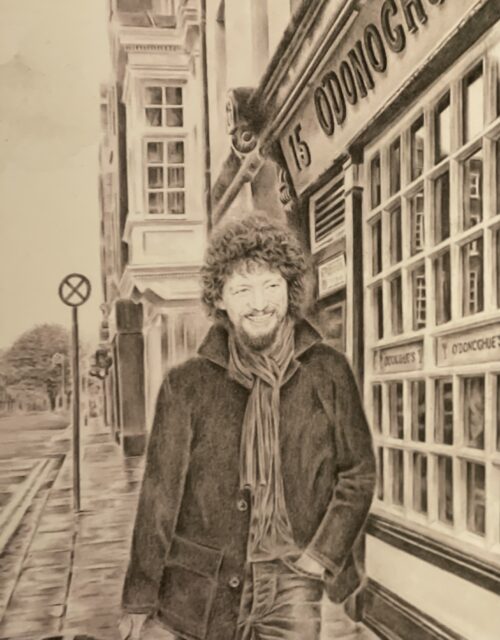
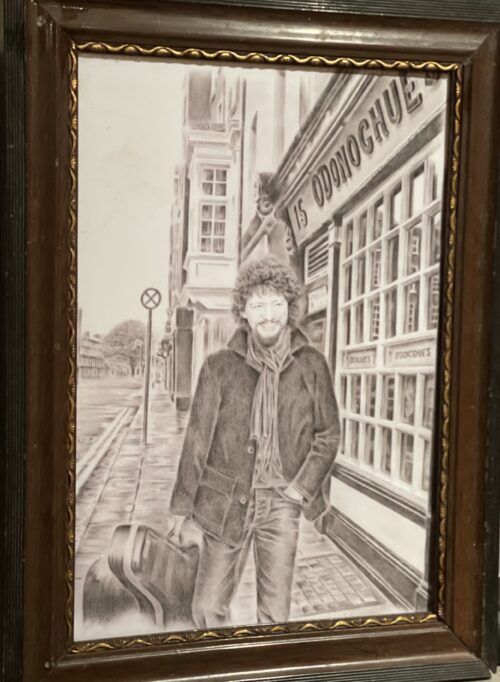 40cm x 30cm Luke Kelly (17 November 1940 – 30 January 1984) was an Irish singer, folk musician and actor from Dublin, Ireland. Born into a working-class household in Dublin city, Kelly moved to England in his late teens and by his early 20s had become involved in a folk music revival. Returning to Dublin in the 1960s, he is noted as a founding member of the band The Dubliners in 1962. Becoming known for his distinctive singing style, and sometimes political messages, the Irish Postand other commentators have regarded Kelly as one of Ireland's greatest folk singers. Early life Luke Kelly was born into a working-class family in Lattimore Cottages at 1 Sheriff Street.His maternal grandmother, who was a MacDonald from Scotland, lived with the family until her death in 1953. His father who was Irish- also named Luke- was shot and severely wounded as a child by British soldiers from the King's Own Scottish Borderers during the 1914 Bachelor's Walk massacre.His father worked all his life in Jacob's biscuit factory and enjoyed playing football. The elder Luke was a keen singer: Luke junior's brother Paddy later recalled that "he had this talent... to sing negro spirituals by people like Paul Robeson, we used to sit around and join in — that was our entertainment". After Dublin Corporation demolished Lattimore Cottages in 1942, the Kellys became the first family to move into the St. Laurence O’Toole flats, where Luke spent the bulk of his childhood, although the family were forced to move by a fire in 1953 and settled in the Whitehall area. Both Luke and Paddy played club Gaelic football and soccer as children. Kelly left school at thirteen and after a number of years of odd-jobbing, he went to England in 1958.[6] Working at steel fixing with his brother Paddy on a building site in Wolverhampton, he was apparently sacked after asking for higher pay. He worked a number of odd jobs, including a period as a vacuum cleaner salesman.Describing himself as a beatnik, he travelled Northern England in search of work, summarising his life in this period as "cleaning lavatories, cleaning windows, cleaning railways, but very rarely cleaning my face".
40cm x 30cm Luke Kelly (17 November 1940 – 30 January 1984) was an Irish singer, folk musician and actor from Dublin, Ireland. Born into a working-class household in Dublin city, Kelly moved to England in his late teens and by his early 20s had become involved in a folk music revival. Returning to Dublin in the 1960s, he is noted as a founding member of the band The Dubliners in 1962. Becoming known for his distinctive singing style, and sometimes political messages, the Irish Postand other commentators have regarded Kelly as one of Ireland's greatest folk singers. Early life Luke Kelly was born into a working-class family in Lattimore Cottages at 1 Sheriff Street.His maternal grandmother, who was a MacDonald from Scotland, lived with the family until her death in 1953. His father who was Irish- also named Luke- was shot and severely wounded as a child by British soldiers from the King's Own Scottish Borderers during the 1914 Bachelor's Walk massacre.His father worked all his life in Jacob's biscuit factory and enjoyed playing football. The elder Luke was a keen singer: Luke junior's brother Paddy later recalled that "he had this talent... to sing negro spirituals by people like Paul Robeson, we used to sit around and join in — that was our entertainment". After Dublin Corporation demolished Lattimore Cottages in 1942, the Kellys became the first family to move into the St. Laurence O’Toole flats, where Luke spent the bulk of his childhood, although the family were forced to move by a fire in 1953 and settled in the Whitehall area. Both Luke and Paddy played club Gaelic football and soccer as children. Kelly left school at thirteen and after a number of years of odd-jobbing, he went to England in 1958.[6] Working at steel fixing with his brother Paddy on a building site in Wolverhampton, he was apparently sacked after asking for higher pay. He worked a number of odd jobs, including a period as a vacuum cleaner salesman.Describing himself as a beatnik, he travelled Northern England in search of work, summarising his life in this period as "cleaning lavatories, cleaning windows, cleaning railways, but very rarely cleaning my face".Musical beginnings
Kelly had been interested in music during his teenage years: he regularly attended céilithe with his sister Mona and listened to American vocalists including: Fats Domino, Al Jolson, Frank Sinatra and Perry Como. He also had an interest in theatre and musicals, being involved with the staging of plays by Dublin's Marian Arts Society. The first folk club he came across was in the Bridge Hotel, Newcastle upon Tyne in early 1960.Having already acquired the use of a banjo, he started memorising songs. In Leeds he brought his banjo to sessions in McReady's pub. The folk revival was under way in England: at the centre of it was Ewan MacColl who scripted a radio programme called Ballads and Blues. A revival in the skiffle genre also injected a certain energy into folk singing at the time. Kelly started busking. On a trip home he went to a fleadh cheoil in Milltown Malbay on the advice of Johnny Moynihan. He listened to recordings of Woody Guthrie and Pete Seeger. He also developed his political convictions which, as Ronnie Drew pointed out after his death, he stuck to throughout his life. As Drew also pointed out, he "learned to sing with perfect diction". Kelly befriended Sean Mulready in Birmingham and lived in his home for a period.Mulready was a teacher who was forced from his job in Dublin because of his communist beliefs. Mulready had strong music links; a sister, Kathleen Moynihan was a founder member of Comhaltas Ceoltóirí Éireann, and he was related by marriage to Festy Conlon, the County Galway whistle player. Mulready's brother-in-law, Ned Stapleton, taught Kelly "The Rocky Road to Dublin".During this period he studied literature and politics under the tutelage of Mulready, his wife Mollie, and Marxist classicist George Derwent Thomson: Kelly later stated that his interest in music grew parallel to his interest in politics. Kelly bought his first banjo, which had five strings and a long neck, and played it in the style of Pete Seeger and Tommy Makem. At the same time, Kelly began a habit of reading, and also began playing golf on one of Birmingham's municipal courses. He got involved in the Jug O'Punch folk club run by Ian Campbell. He befriended Dominic Behan and they performed in folk clubs and Irish pubs from London to Glasgow. In London pubs, like "The Favourite", he would hear street singer Margaret Barry and musicians in exile like Roger Sherlock, Seamus Ennis, Bobby Casey and Mairtín Byrnes. Luke Kelly was by now active in the Connolly Association, a left-wing grouping strongest among the emigres in England, and he also joined the Young Communist League: he toured Irish pubs playing his set and selling the Connolly Association's newspaper The Irish Democrat. By 1962 George Derwent Thomson had offered him the opportunity to further his educational and political development by attending university in Prague. However, Kelly turned down the offer in favour of pursuing his career in folk music. He was also to start frequenting Ewan MacColl and Peggy Seeger's Singer Club in London.The Dubliners
In 1961 there was a folk music revival or "ballad boom", as it was later termed, in waiting in Ireland.The Abbey Tavern sessions in Howth were the forerunner to sessions in the Hollybrook, Clontarf, the International Bar and the Grafton Cinema. Luke Kelly returned to Dublin in 1962. O'Donoghue's Pub was already established as a session house and soon Kelly was singing with, among others, Ronnie Drew and Barney McKenna. Other early people playing at O'Donoghues included The Fureys, father and sons, John Keenan and Sean Og McKenna, Johnny Moynihan, Andy Irvine, Seamus Ennis, Willy Clancy and Mairtin Byrnes. A concert John Molloy organised in the Hibernian Hotel led to his "Ballad Tour of Ireland" with the Ronnie Drew Ballad Group (billed in one town as the Ronnie Drew Ballet Group). This tour led to the Abbey Tavern and the Royal Marine Hotel and then to jam-packed sessions in the Embankment, Tallaght. Ciarán Bourke joined the group, followed later by John Sheahan. They renamed themselves The Dubliners at Kelly's suggestion, as he was reading James Joyce's book of short stories, entitled Dubliners, at the time.Kelly was the leading vocalist for the group's eponymous debut album in 1964, which included his rendition of "The Rocky Road to Dublin". Barney McKenna later noted that Kelly was the only singer he'd heard sing it to the rhythm it was played on the fiddle. In 1964 Luke Kelly left the group for nearly two years and was replaced by Bobby Lynch and John Sheahan. Kelly went with Deirdre O'Connell, founder of the Focus Theatre, whom he was to marry the following year, back to London and became involved in Ewan MacColl's "gathering". The Critics, as it was called, was formed to explore folk traditions and help young singers. During this period he retained his political commitments, becoming increasingly active in the Campaign for Nuclear Disarmament. Kelly also met and befriended Michael O'Riordan, the General Secretary of the Irish Workers' Party, and the two developed a "personal-political friendship". Kelly endorsed O'Riordan for election, and held a rally in his name during campaigning in 1965.In 1965, he sang 'The Rocky Road to Dublin' with Liam Clancy on his first, self-titled solo album. Bobby Lynch left The Dubliners, John Sheahan and Kelly rejoined. They recorded an album in the Gate Theatre, Dublin, played the Cambridge Folk Festival and recorded Irish Night Out, a live album with, among others, exiles Margaret Barry, Michael Gorman and Jimmy Powers. They also played a concert in the National Stadium in Dublin with Pete Seeger as special guest. They were on the road to success: Top Twenty hits with "Seven Drunken Nights" and "The Black Velvet Band", The Ed Sullivan Show in 1968 and a tour of New Zealand and Australia. The ballad boom in Ireland was becoming increasingly commercialised with bar and pub owners building ever larger venues for pay-in performances. Ewan MacColl and Peggy Seeger on a visit to Dublin expressed concern to Kelly about his drinking.[citation needed] Christy Moore and Kelly became acquainted in the 1960s.During his Planxty days, Moore got to know Kelly well. In 1972 The Dubliners themselves performed in Richard's Cork Leg, based on the "incomplete works" of Brendan Behan. In 1973, Kelly took to the stage performing as King Herod in Jesus Christ Superstar. The arrival of a new manager for The Dubliners, Derry composer Phil Coulter, resulted in a collaboration that produced three of Kelly's most notable performances: “The Town I Loved So Well”, "Hand me Down my Bible", and “Scorn Not His Simplicity”, a song about Phil's son who had Down Syndrome.Kelly had such respect for the latter song that he only performed it once for a television recording and rarely, if ever, sang it at the Dubliners' often boisterous events. His interpretations of “On Raglan Road” and "Scorn Not His Simplicity" became significant points of reference in Irish folk music.His version of "Raglan Road" came about when the poem's author, Patrick Kavanagh, heard him singing in a Dublin pub, and approached Kelly to say that he should sing the poem (which is set to the tune of “The Dawning of the Day”). Kelly remained a politically engaged musician, becoming a supporter of the movement against South African apartheid and performing at benefit concerts for the Irish Traveller community,and many of the songs he recorded dealt with social issues, the arms race and the Cold War, trade unionism and Irish republicanism, ("The Springhill Disaster", "Joe Hill", "The Button Pusher", "Alabama 1958" and "God Save Ireland" all being examples of his concerns).Personal life
Luke Kelly married Deirdre O'Connell in 1965, but they separated in the early 1970s.Kelly spent the last eight years of his life living with his partner Madeleine Seiler, who is from Germany.Final years
Kelly's health deteriorated in the 1970s. Kelly himself spoke about his problems with alcohol. On 30 June 1980 during a concert in the Cork Opera House he collapsed on the stage. He had already suffered for some time from migraines and forgetfulness - including forgetting what country he was in whilst visiting Iceland - which had been ascribed to his intense schedule, alcohol consumption, and "party lifestyle". A brain tumour was diagnosed.Although Kelly toured with the Dubliners after enduring an operation, his health deteriorated further. He forgot lyrics and had to take longer breaks in concerts as he felt weak. In addition following his emergency surgery after his collapse in Cork, he became more withdrawn, preferring the company of Madeleine at home to performing.On his European tour he managed to perform with the band for most of the show in Carre for their Live in Carre album. However, in autumn 1983 he had to leave the stage in Traun, Austria and again in Mannheim, Germany. Shortly after this, he had to cancel the tour of southern Germany, and after a short stay in hospital in Heidelberg he was flown back to Dublin. After another operation he spent Christmas with his family but was taken into hospital again in the New Year, where he died on 30 January 1984.Kelly's funeral in Whitehall attracted thousands of mourners from across Ireland.His gravestone in Glasnevin Cemetery, Dublin, bears the inscription: Luke Kelly – Dubliner. Sean Cannon took Kelly's place in The Dubliners. He had been performing with the Dubliners since 1982,due to the deterioration of Kelly's health.Legacy
Luke Kelly's legacy and contributions to Irish music and culture have been described as "iconic" and have been captured in a number of documentaries and anthologies. The influence of his Scottish grandmother was influential in Kelly's help in preserving important traditional Scottish songs such as "Mormond Braes", the Canadian folk song "Peggy Gordon", "Robert Burns", "Parcel of Rogues", "Tibbie Dunbar", Hamish Henderson's "Freedom Come-All-Ye", and Thurso Berwick's "Scottish Breakaway". The Ballybough Bridge in the north inner city of Dublin was renamed the Luke Kelly Bridge, and in November 2004 Dublin City Council voted unanimously to erect a bronze statue of Luke Kelly. However, the Dublin Docklands Authority subsequently stated that it could no longer afford to fund the statue. In 2010, councillor Christy Burke of Dublin City Council appealed to members of the music community including Bono, Phil Coulter and Enya to help build it. Paddy Reilly recorded a tribute to Kelly entitled "The Dublin Minstrel". It featured on his Gold And Silver Years, Celtic Collections and the Essential Paddy Reilly CD's. The Dubliners recorded the song on their Live at Vicar Street DVD/CD. The song was composed by Declan O'Donoghue, the Racing Correspondent of The Irish Sun. At Christmas 2005 writer-director Michael Feeney Callan's documentary, Luke Kelly: The Performer, was released and outsold U2's latest DVD during the festive season and into 2006, acquiring platinum sales status. The documentary told Kelly's story through the words of the Dubliners, Donovan, Ralph McTell and others and featured full versions of rarely seen performances such as the early sixties' Ed Sullivan Show. A later documentary, Luke Kelly: Prince of the City, was also well received. Two statues of Kelly were unveiled in Dublin in January 2019, to mark the 35th anniversary of his death.One, a life-size seated bronze by John Coll, is on South King Street. The second sculpture, a marble portrait head by Vera Klute, is on Sheriff Street. The Klute sculpture was vandalised on several occasions in 2019 and 2020, in each case being restored by graffiti-removal specialists. Sculpture of Luke Kelly on Sheriff Street by Vera Klute. Unveiled in 2019
Sculpture of Luke Kelly on Sheriff Street by Vera Klute. Unveiled in 2019 -
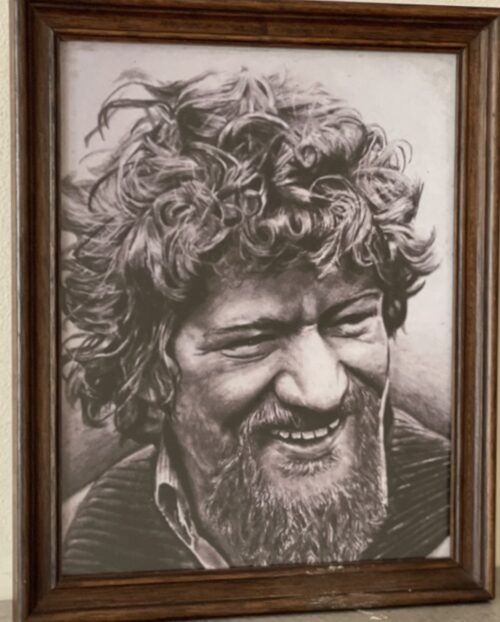 40cm x 30cm Luke Kelly (17 November 1940 – 30 January 1984) was an Irish singer, folk musician and actor from Dublin, Ireland. Born into a working-class household in Dublin city, Kelly moved to England in his late teens and by his early 20s had become involved in a folk music revival. Returning to Dublin in the 1960s, he is noted as a founding member of the band The Dubliners in 1962. Becoming known for his distinctive singing style, and sometimes political messages, the Irish Postand other commentators have regarded Kelly as one of Ireland's greatest folk singers. Early life Luke Kelly was born into a working-class family in Lattimore Cottages at 1 Sheriff Street.His maternal grandmother, who was a MacDonald from Scotland, lived with the family until her death in 1953. His father who was Irish- also named Luke- was shot and severely wounded as a child by British soldiers from the King's Own Scottish Borderers during the 1914 Bachelor's Walk massacre.His father worked all his life in Jacob's biscuit factory and enjoyed playing football. The elder Luke was a keen singer: Luke junior's brother Paddy later recalled that "he had this talent... to sing negro spirituals by people like Paul Robeson, we used to sit around and join in — that was our entertainment". After Dublin Corporation demolished Lattimore Cottages in 1942, the Kellys became the first family to move into the St. Laurence O’Toole flats, where Luke spent the bulk of his childhood, although the family were forced to move by a fire in 1953 and settled in the Whitehall area. Both Luke and Paddy played club Gaelic football and soccer as children. Kelly left school at thirteen and after a number of years of odd-jobbing, he went to England in 1958.[6] Working at steel fixing with his brother Paddy on a building site in Wolverhampton, he was apparently sacked after asking for higher pay. He worked a number of odd jobs, including a period as a vacuum cleaner salesman.Describing himself as a beatnik, he travelled Northern England in search of work, summarising his life in this period as "cleaning lavatories, cleaning windows, cleaning railways, but very rarely cleaning my face".
40cm x 30cm Luke Kelly (17 November 1940 – 30 January 1984) was an Irish singer, folk musician and actor from Dublin, Ireland. Born into a working-class household in Dublin city, Kelly moved to England in his late teens and by his early 20s had become involved in a folk music revival. Returning to Dublin in the 1960s, he is noted as a founding member of the band The Dubliners in 1962. Becoming known for his distinctive singing style, and sometimes political messages, the Irish Postand other commentators have regarded Kelly as one of Ireland's greatest folk singers. Early life Luke Kelly was born into a working-class family in Lattimore Cottages at 1 Sheriff Street.His maternal grandmother, who was a MacDonald from Scotland, lived with the family until her death in 1953. His father who was Irish- also named Luke- was shot and severely wounded as a child by British soldiers from the King's Own Scottish Borderers during the 1914 Bachelor's Walk massacre.His father worked all his life in Jacob's biscuit factory and enjoyed playing football. The elder Luke was a keen singer: Luke junior's brother Paddy later recalled that "he had this talent... to sing negro spirituals by people like Paul Robeson, we used to sit around and join in — that was our entertainment". After Dublin Corporation demolished Lattimore Cottages in 1942, the Kellys became the first family to move into the St. Laurence O’Toole flats, where Luke spent the bulk of his childhood, although the family were forced to move by a fire in 1953 and settled in the Whitehall area. Both Luke and Paddy played club Gaelic football and soccer as children. Kelly left school at thirteen and after a number of years of odd-jobbing, he went to England in 1958.[6] Working at steel fixing with his brother Paddy on a building site in Wolverhampton, he was apparently sacked after asking for higher pay. He worked a number of odd jobs, including a period as a vacuum cleaner salesman.Describing himself as a beatnik, he travelled Northern England in search of work, summarising his life in this period as "cleaning lavatories, cleaning windows, cleaning railways, but very rarely cleaning my face".Musical beginnings
Kelly had been interested in music during his teenage years: he regularly attended céilithe with his sister Mona and listened to American vocalists including: Fats Domino, Al Jolson, Frank Sinatra and Perry Como. He also had an interest in theatre and musicals, being involved with the staging of plays by Dublin's Marian Arts Society. The first folk club he came across was in the Bridge Hotel, Newcastle upon Tyne in early 1960.Having already acquired the use of a banjo, he started memorising songs. In Leeds he brought his banjo to sessions in McReady's pub. The folk revival was under way in England: at the centre of it was Ewan MacColl who scripted a radio programme called Ballads and Blues. A revival in the skiffle genre also injected a certain energy into folk singing at the time. Kelly started busking. On a trip home he went to a fleadh cheoil in Milltown Malbay on the advice of Johnny Moynihan. He listened to recordings of Woody Guthrie and Pete Seeger. He also developed his political convictions which, as Ronnie Drew pointed out after his death, he stuck to throughout his life. As Drew also pointed out, he "learned to sing with perfect diction". Kelly befriended Sean Mulready in Birmingham and lived in his home for a period.Mulready was a teacher who was forced from his job in Dublin because of his communist beliefs. Mulready had strong music links; a sister, Kathleen Moynihan was a founder member of Comhaltas Ceoltóirí Éireann, and he was related by marriage to Festy Conlon, the County Galway whistle player. Mulready's brother-in-law, Ned Stapleton, taught Kelly "The Rocky Road to Dublin".During this period he studied literature and politics under the tutelage of Mulready, his wife Mollie, and Marxist classicist George Derwent Thomson: Kelly later stated that his interest in music grew parallel to his interest in politics. Kelly bought his first banjo, which had five strings and a long neck, and played it in the style of Pete Seeger and Tommy Makem. At the same time, Kelly began a habit of reading, and also began playing golf on one of Birmingham's municipal courses. He got involved in the Jug O'Punch folk club run by Ian Campbell. He befriended Dominic Behan and they performed in folk clubs and Irish pubs from London to Glasgow. In London pubs, like "The Favourite", he would hear street singer Margaret Barry and musicians in exile like Roger Sherlock, Seamus Ennis, Bobby Casey and Mairtín Byrnes. Luke Kelly was by now active in the Connolly Association, a left-wing grouping strongest among the emigres in England, and he also joined the Young Communist League: he toured Irish pubs playing his set and selling the Connolly Association's newspaper The Irish Democrat. By 1962 George Derwent Thomson had offered him the opportunity to further his educational and political development by attending university in Prague. However, Kelly turned down the offer in favour of pursuing his career in folk music. He was also to start frequenting Ewan MacColl and Peggy Seeger's Singer Club in London.The Dubliners
In 1961 there was a folk music revival or "ballad boom", as it was later termed, in waiting in Ireland.The Abbey Tavern sessions in Howth were the forerunner to sessions in the Hollybrook, Clontarf, the International Bar and the Grafton Cinema. Luke Kelly returned to Dublin in 1962. O'Donoghue's Pub was already established as a session house and soon Kelly was singing with, among others, Ronnie Drew and Barney McKenna. Other early people playing at O'Donoghues included The Fureys, father and sons, John Keenan and Sean Og McKenna, Johnny Moynihan, Andy Irvine, Seamus Ennis, Willy Clancy and Mairtin Byrnes. A concert John Molloy organised in the Hibernian Hotel led to his "Ballad Tour of Ireland" with the Ronnie Drew Ballad Group (billed in one town as the Ronnie Drew Ballet Group). This tour led to the Abbey Tavern and the Royal Marine Hotel and then to jam-packed sessions in the Embankment, Tallaght. Ciarán Bourke joined the group, followed later by John Sheahan. They renamed themselves The Dubliners at Kelly's suggestion, as he was reading James Joyce's book of short stories, entitled Dubliners, at the time.Kelly was the leading vocalist for the group's eponymous debut album in 1964, which included his rendition of "The Rocky Road to Dublin". Barney McKenna later noted that Kelly was the only singer he'd heard sing it to the rhythm it was played on the fiddle. In 1964 Luke Kelly left the group for nearly two years and was replaced by Bobby Lynch and John Sheahan. Kelly went with Deirdre O'Connell, founder of the Focus Theatre, whom he was to marry the following year, back to London and became involved in Ewan MacColl's "gathering". The Critics, as it was called, was formed to explore folk traditions and help young singers. During this period he retained his political commitments, becoming increasingly active in the Campaign for Nuclear Disarmament. Kelly also met and befriended Michael O'Riordan, the General Secretary of the Irish Workers' Party, and the two developed a "personal-political friendship". Kelly endorsed O'Riordan for election, and held a rally in his name during campaigning in 1965.In 1965, he sang 'The Rocky Road to Dublin' with Liam Clancy on his first, self-titled solo album. Bobby Lynch left The Dubliners, John Sheahan and Kelly rejoined. They recorded an album in the Gate Theatre, Dublin, played the Cambridge Folk Festival and recorded Irish Night Out, a live album with, among others, exiles Margaret Barry, Michael Gorman and Jimmy Powers. They also played a concert in the National Stadium in Dublin with Pete Seeger as special guest. They were on the road to success: Top Twenty hits with "Seven Drunken Nights" and "The Black Velvet Band", The Ed Sullivan Show in 1968 and a tour of New Zealand and Australia. The ballad boom in Ireland was becoming increasingly commercialised with bar and pub owners building ever larger venues for pay-in performances. Ewan MacColl and Peggy Seeger on a visit to Dublin expressed concern to Kelly about his drinking.[citation needed] Christy Moore and Kelly became acquainted in the 1960s.During his Planxty days, Moore got to know Kelly well. In 1972 The Dubliners themselves performed in Richard's Cork Leg, based on the "incomplete works" of Brendan Behan. In 1973, Kelly took to the stage performing as King Herod in Jesus Christ Superstar. The arrival of a new manager for The Dubliners, Derry composer Phil Coulter, resulted in a collaboration that produced three of Kelly's most notable performances: “The Town I Loved So Well”, "Hand me Down my Bible", and “Scorn Not His Simplicity”, a song about Phil's son who had Down Syndrome.Kelly had such respect for the latter song that he only performed it once for a television recording and rarely, if ever, sang it at the Dubliners' often boisterous events. His interpretations of “On Raglan Road” and "Scorn Not His Simplicity" became significant points of reference in Irish folk music.His version of "Raglan Road" came about when the poem's author, Patrick Kavanagh, heard him singing in a Dublin pub, and approached Kelly to say that he should sing the poem (which is set to the tune of “The Dawning of the Day”). Kelly remained a politically engaged musician, becoming a supporter of the movement against South African apartheid and performing at benefit concerts for the Irish Traveller community,and many of the songs he recorded dealt with social issues, the arms race and the Cold War, trade unionism and Irish republicanism, ("The Springhill Disaster", "Joe Hill", "The Button Pusher", "Alabama 1958" and "God Save Ireland" all being examples of his concerns).Personal life
Luke Kelly married Deirdre O'Connell in 1965, but they separated in the early 1970s.Kelly spent the last eight years of his life living with his partner Madeleine Seiler, who is from Germany.Final years
Kelly's health deteriorated in the 1970s. Kelly himself spoke about his problems with alcohol. On 30 June 1980 during a concert in the Cork Opera House he collapsed on the stage. He had already suffered for some time from migraines and forgetfulness - including forgetting what country he was in whilst visiting Iceland - which had been ascribed to his intense schedule, alcohol consumption, and "party lifestyle". A brain tumour was diagnosed.Although Kelly toured with the Dubliners after enduring an operation, his health deteriorated further. He forgot lyrics and had to take longer breaks in concerts as he felt weak. In addition following his emergency surgery after his collapse in Cork, he became more withdrawn, preferring the company of Madeleine at home to performing.On his European tour he managed to perform with the band for most of the show in Carre for their Live in Carre album. However, in autumn 1983 he had to leave the stage in Traun, Austria and again in Mannheim, Germany. Shortly after this, he had to cancel the tour of southern Germany, and after a short stay in hospital in Heidelberg he was flown back to Dublin. After another operation he spent Christmas with his family but was taken into hospital again in the New Year, where he died on 30 January 1984.Kelly's funeral in Whitehall attracted thousands of mourners from across Ireland.His gravestone in Glasnevin Cemetery, Dublin, bears the inscription: Luke Kelly – Dubliner. Sean Cannon took Kelly's place in The Dubliners. He had been performing with the Dubliners since 1982,due to the deterioration of Kelly's health.Legacy
Luke Kelly's legacy and contributions to Irish music and culture have been described as "iconic" and have been captured in a number of documentaries and anthologies. The influence of his Scottish grandmother was influential in Kelly's help in preserving important traditional Scottish songs such as "Mormond Braes", the Canadian folk song "Peggy Gordon", "Robert Burns", "Parcel of Rogues", "Tibbie Dunbar", Hamish Henderson's "Freedom Come-All-Ye", and Thurso Berwick's "Scottish Breakaway". The Ballybough Bridge in the north inner city of Dublin was renamed the Luke Kelly Bridge, and in November 2004 Dublin City Council voted unanimously to erect a bronze statue of Luke Kelly. However, the Dublin Docklands Authority subsequently stated that it could no longer afford to fund the statue. In 2010, councillor Christy Burke of Dublin City Council appealed to members of the music community including Bono, Phil Coulter and Enya to help build it. Paddy Reilly recorded a tribute to Kelly entitled "The Dublin Minstrel". It featured on his Gold And Silver Years, Celtic Collections and the Essential Paddy Reilly CD's. The Dubliners recorded the song on their Live at Vicar Street DVD/CD. The song was composed by Declan O'Donoghue, the Racing Correspondent of The Irish Sun. At Christmas 2005 writer-director Michael Feeney Callan's documentary, Luke Kelly: The Performer, was released and outsold U2's latest DVD during the festive season and into 2006, acquiring platinum sales status. The documentary told Kelly's story through the words of the Dubliners, Donovan, Ralph McTell and others and featured full versions of rarely seen performances such as the early sixties' Ed Sullivan Show. A later documentary, Luke Kelly: Prince of the City, was also well received. Two statues of Kelly were unveiled in Dublin in January 2019, to mark the 35th anniversary of his death.One, a life-size seated bronze by John Coll, is on South King Street. The second sculpture, a marble portrait head by Vera Klute, is on Sheriff Street. The Klute sculpture was vandalised on several occasions in 2019 and 2020, in each case being restored by graffiti-removal specialists. Sculpture of Luke Kelly on Sheriff Street by Vera Klute. Unveiled in 2019
Sculpture of Luke Kelly on Sheriff Street by Vera Klute. Unveiled in 2019 -
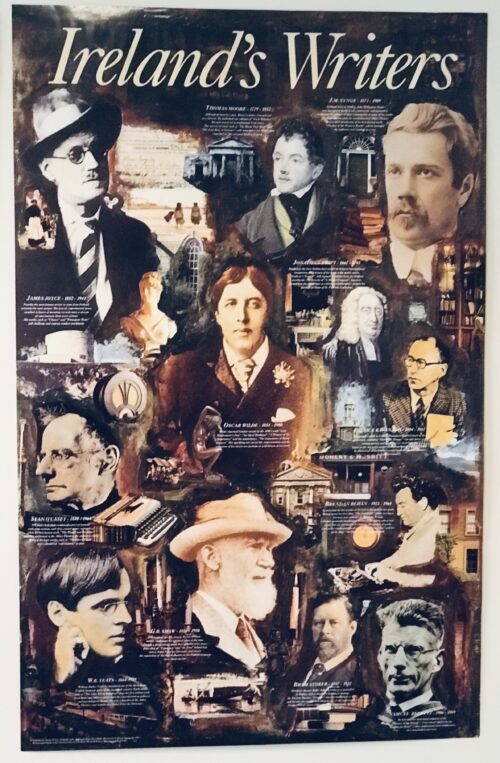
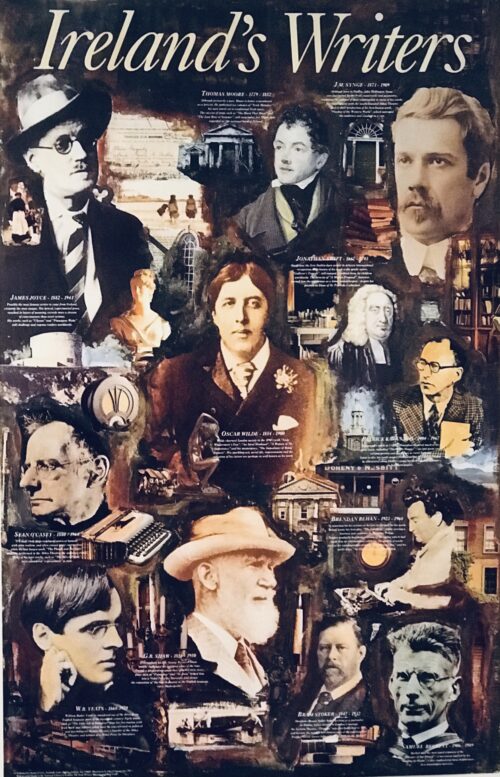 Superb poster depicting the myriad of Irish literary greats throughout the ages -to name but a few,Thomas Moore,JM Synge,WB Yeats,Joyce,Oscar Wilde,Patrick Kavanagh,G.B Shaw etc 84cm x 54cm Irish Literature comprises writings in the Irish, Latin, and English (including Ulster Scots) languages on the island of Ireland. The earliest recorded Irish writing dates from the seventh century and was produced by monks writing in both Latin and Early Irish. In addition to scriptural writing, the monks of Ireland recorded both poetry and mythological tales. There is a large surviving body of Irish mythological writing, including tales such as The Táin and Mad King Sweeny. The English language was introduced to Ireland in the thirteenth century, following the Norman invasion of Ireland. The Irish language, however, remained the dominant language of Irish literature down to the nineteenth century, despite a slow decline which began in the seventeenth century with the expansion of English power. The latter part of the nineteenth century saw a rapid replacement of Irish by English in the greater part of the country. At the end of the century, however, cultural nationalism displayed a new energy, marked by the Gaelic Revival(which encouraged a modern literature in Irish) and more generally by the Irish Literary Revival. The Anglo-Irish literary tradition found its first great exponents in Richard Head and Jonathan Swift followed by Laurence Sterne, Oliver Goldsmith and Richard Brinsley Sheridan. At the end of 19th century and throughout the 20th century, the Irish literature get an unprecedented sequence of worldwide successful works, especially those by Oscar Wilde, Bram Stoker, James Joyce, W. B. Yeats, Samuel Beckett, C.S. Lewis and George Bernard Shaw, prominent writers who left Ireland to make a life in other European countries such as England, France and Switzerland. The descendants of Scottish settlers in Ulster formed the Ulster-Scots writing tradition, having an especially strong tradition of rhyming poetry. Though English was the dominant Irish literary language in the twentieth century, much work of high quality appeared in Irish Gaelic. A pioneering modernist writer in Irish was Pádraic Ó Conaire, and traditional life was given vigorous expression in a series of autobiographies by native Irish speakers from the west coast, exemplified by the work of Tomás Ó Criomhthain and Peig Sayers. The outstanding modernist prose writer in Irish was Máirtín Ó Cadhain, and prominent poets included Máirtín Ó Direáin, Seán Ó Ríordáin and Máire Mhac an tSaoi. Prominent bilingual writers included Brendan Behan (who wrote poetry and a play in Irish) and Flann O'Brien. Two novels by O'Brien, At Swim Two Birdsand The Third Policeman, are considered early examples of postmodern fiction, but he also wrote a satirical novel in Irish called An Béal Bocht(translated as The Poor Mouth). Liam O'Flaherty, who gained fame as a writer in English, also published a book of short stories in Irish (Dúil). Most attention has been given to Irish writers who wrote in English and who were at the forefront of the modernist movement, notably James Joyce, whose novel Ulysses is considered one of the most influential of the century. The playwright Samuel Beckett, in addition to a large amount of prose fiction, wrote a number of important plays, including Waiting for Godot. Several Irish writers have excelled at short story writing, in particular Frank O'Connor and William Trevor. In the late twentieth century Irish poets, especially those from Northern Ireland, came to prominence with Derek Mahon, John Montague, Seamus Heaney and Paul Muldoon. Other notable Irish writers from the twentieth century include, poet Patrick Kavanagh, dramatists Tom Murphy and Brian Friel and novelists Edna O'Brien and John McGahern. Well-known Irish writers in English in the twenty-first century include Colum McCann, Anne Enright, Roddy Doyle, Sebastian Barry, Colm Toibín and John Banville, all of whom have all won major awards. Younger writers include Paul Murray, Kevin Barry, Emma Donoghue, Donal Ryan and dramatist Martin McDonagh. Writing in Irish has also continued to flourish. Origins : Dublin Dimensions : 90cm x 60cm 8kg
Superb poster depicting the myriad of Irish literary greats throughout the ages -to name but a few,Thomas Moore,JM Synge,WB Yeats,Joyce,Oscar Wilde,Patrick Kavanagh,G.B Shaw etc 84cm x 54cm Irish Literature comprises writings in the Irish, Latin, and English (including Ulster Scots) languages on the island of Ireland. The earliest recorded Irish writing dates from the seventh century and was produced by monks writing in both Latin and Early Irish. In addition to scriptural writing, the monks of Ireland recorded both poetry and mythological tales. There is a large surviving body of Irish mythological writing, including tales such as The Táin and Mad King Sweeny. The English language was introduced to Ireland in the thirteenth century, following the Norman invasion of Ireland. The Irish language, however, remained the dominant language of Irish literature down to the nineteenth century, despite a slow decline which began in the seventeenth century with the expansion of English power. The latter part of the nineteenth century saw a rapid replacement of Irish by English in the greater part of the country. At the end of the century, however, cultural nationalism displayed a new energy, marked by the Gaelic Revival(which encouraged a modern literature in Irish) and more generally by the Irish Literary Revival. The Anglo-Irish literary tradition found its first great exponents in Richard Head and Jonathan Swift followed by Laurence Sterne, Oliver Goldsmith and Richard Brinsley Sheridan. At the end of 19th century and throughout the 20th century, the Irish literature get an unprecedented sequence of worldwide successful works, especially those by Oscar Wilde, Bram Stoker, James Joyce, W. B. Yeats, Samuel Beckett, C.S. Lewis and George Bernard Shaw, prominent writers who left Ireland to make a life in other European countries such as England, France and Switzerland. The descendants of Scottish settlers in Ulster formed the Ulster-Scots writing tradition, having an especially strong tradition of rhyming poetry. Though English was the dominant Irish literary language in the twentieth century, much work of high quality appeared in Irish Gaelic. A pioneering modernist writer in Irish was Pádraic Ó Conaire, and traditional life was given vigorous expression in a series of autobiographies by native Irish speakers from the west coast, exemplified by the work of Tomás Ó Criomhthain and Peig Sayers. The outstanding modernist prose writer in Irish was Máirtín Ó Cadhain, and prominent poets included Máirtín Ó Direáin, Seán Ó Ríordáin and Máire Mhac an tSaoi. Prominent bilingual writers included Brendan Behan (who wrote poetry and a play in Irish) and Flann O'Brien. Two novels by O'Brien, At Swim Two Birdsand The Third Policeman, are considered early examples of postmodern fiction, but he also wrote a satirical novel in Irish called An Béal Bocht(translated as The Poor Mouth). Liam O'Flaherty, who gained fame as a writer in English, also published a book of short stories in Irish (Dúil). Most attention has been given to Irish writers who wrote in English and who were at the forefront of the modernist movement, notably James Joyce, whose novel Ulysses is considered one of the most influential of the century. The playwright Samuel Beckett, in addition to a large amount of prose fiction, wrote a number of important plays, including Waiting for Godot. Several Irish writers have excelled at short story writing, in particular Frank O'Connor and William Trevor. In the late twentieth century Irish poets, especially those from Northern Ireland, came to prominence with Derek Mahon, John Montague, Seamus Heaney and Paul Muldoon. Other notable Irish writers from the twentieth century include, poet Patrick Kavanagh, dramatists Tom Murphy and Brian Friel and novelists Edna O'Brien and John McGahern. Well-known Irish writers in English in the twenty-first century include Colum McCann, Anne Enright, Roddy Doyle, Sebastian Barry, Colm Toibín and John Banville, all of whom have all won major awards. Younger writers include Paul Murray, Kevin Barry, Emma Donoghue, Donal Ryan and dramatist Martin McDonagh. Writing in Irish has also continued to flourish. Origins : Dublin Dimensions : 90cm x 60cm 8kg -
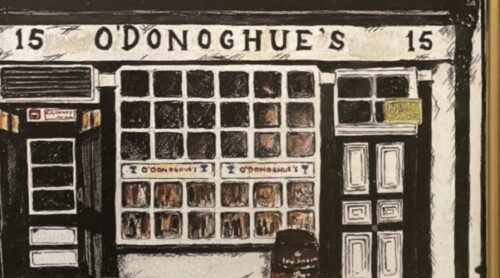
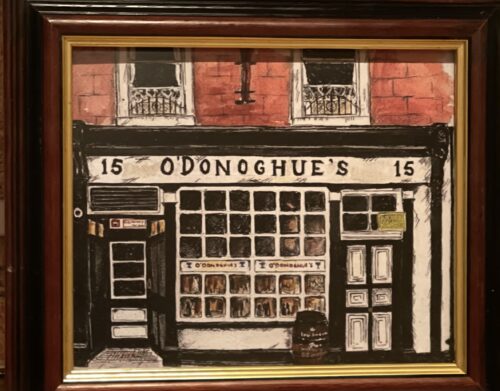 46cm x 33cm
46cm x 33cmHistory
This pub is closely associated with Irish traditional music and was where the popular Irish folk group, The Dubliners, began performing in the early 1960s. Many other notable Irish musicians—including Séamus Ennis, Joe Heaney, Andy Irvine,Christy Moore, The Fureys and Phil Lynott—have played at O’Donoghue’s, and their photographs are displayed in the pub. Included are portraits of The Dubliners themselves: the five founding members Ronnie Drew, Luke Kelly, Ciarán Bourke, John Sheahan and Barney McKenna, as well as later members Eamonn Campbell and Seán Cannon; these photographs hang to the right of the entrance, where the nightly sessions are played.Andy Irvine wrote the tribute song "O'Donoghue's", in which he reminisces about his early days in Dublin—when he first started frequenting the pub in August 1962. The song was released on the album Changing Trains (2007). Dessie Hynes from Longford bought the bar from Paddy and Maureen O'Donoghue in 1977 and ran the pub with his family for 11 years. In 1988, O’Donoghue’s was purchased by publicans Oliver Barden and John Mahon. Barden is still the proprietor and continues to run the pub with his family and staff to this dayO’Donoghue’s
~ Andy Irvine, 2004It was August 1962 When I first set foot in O’Donoghue’s A world of music, friends and booze Opened up before me I never could’ve guessed as I walked through the door Just what the future had in store A crossroads for my life I saw Lying there to taunt me. -
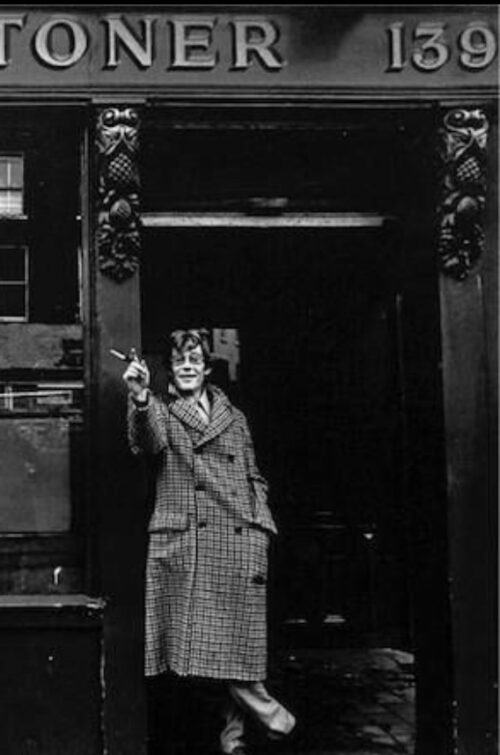
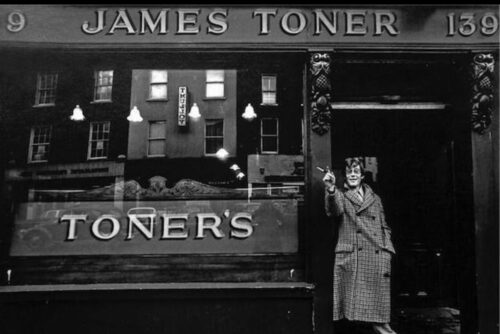 45cm x 35cm. Dublin Iconic b&w photograph of legendary Actor & Bon Viveur Peter O'Toole outside one of his favourite Dublin Watering Hole's-Toners of Baggott Street. Peter Seamus O'Toole ( 2 August 1932 – 14 December 2013) was a British stage and film actor of Irish descent. He attended the Royal Academy of Dramatic Art and began working in the theatre, gaining recognition as a Shakespearean actor at the Bristol Old Vic and with the English Stage Company. In 1959 he made his West End debut in The Long and the Short and the Tall, and played the title role in Hamlet in the National Theatre’s first production in 1963. Excelling on the London stage, O'Toole was known as a "hellraiser" off it. Making his film debut in 1959, O'Toole achieved international recognition playing T. E. Lawrence in Lawrence of Arabia (1962) for which he received his first nomination for the Academy Award for Best Actor. He was nominated for this award another seven times – for playing King Henry II in both Becket (1964) and The Lion in Winter (1968), Goodbye, Mr. Chips (1969), The Ruling Class (1972), The Stunt Man (1980), My Favorite Year (1982), and Venus (2006) – and holds the record for the most Academy Award nominations for acting without a win. In 2002, O'Toole was awarded the Academy Honorary Award for his career achievements. He was additionally the recipient of four Golden Globe Awards, one BAFTA Award for Best British Actor and one Primetime Emmy Award. Brought up in Leeds, England in a Yorkshire Irish family, O'Toole has appeared on lists of greatest actors from publications in England and Ireland. In 2020, he was listed at number 4 on The Irish Times list of Ireland's greatest film actors. Situated on Baggot Street, Toners is one of Dublin’s oldest and most famous traditional pubs. To prove this, we were the overall winners of “Best Traditional Pub” in the National Hospitality Awards 2014. In September 2015 we also won Dublin Bar of the Year at the Sky Bar of the Year Awards. Original features in the pub take visitors back in time, including the old stock drawers behind the bar from when Toners first opened in 1818 as a bar and grocery shop. The interior details like the glazed cabinets filled with curio, elaborate mirrors, the brass bar taps and flagstone floors to mention a few, makes you feel like you are stepping in to a museum… A museum in which you can drink in! Frequented by many of Ireland’s literary greats, including Patrick Kavanagh, the pub was also a favourite spot of W.B. Yeats and the snug is said to be the only place he would drink when he took an occasional tipple.
45cm x 35cm. Dublin Iconic b&w photograph of legendary Actor & Bon Viveur Peter O'Toole outside one of his favourite Dublin Watering Hole's-Toners of Baggott Street. Peter Seamus O'Toole ( 2 August 1932 – 14 December 2013) was a British stage and film actor of Irish descent. He attended the Royal Academy of Dramatic Art and began working in the theatre, gaining recognition as a Shakespearean actor at the Bristol Old Vic and with the English Stage Company. In 1959 he made his West End debut in The Long and the Short and the Tall, and played the title role in Hamlet in the National Theatre’s first production in 1963. Excelling on the London stage, O'Toole was known as a "hellraiser" off it. Making his film debut in 1959, O'Toole achieved international recognition playing T. E. Lawrence in Lawrence of Arabia (1962) for which he received his first nomination for the Academy Award for Best Actor. He was nominated for this award another seven times – for playing King Henry II in both Becket (1964) and The Lion in Winter (1968), Goodbye, Mr. Chips (1969), The Ruling Class (1972), The Stunt Man (1980), My Favorite Year (1982), and Venus (2006) – and holds the record for the most Academy Award nominations for acting without a win. In 2002, O'Toole was awarded the Academy Honorary Award for his career achievements. He was additionally the recipient of four Golden Globe Awards, one BAFTA Award for Best British Actor and one Primetime Emmy Award. Brought up in Leeds, England in a Yorkshire Irish family, O'Toole has appeared on lists of greatest actors from publications in England and Ireland. In 2020, he was listed at number 4 on The Irish Times list of Ireland's greatest film actors. Situated on Baggot Street, Toners is one of Dublin’s oldest and most famous traditional pubs. To prove this, we were the overall winners of “Best Traditional Pub” in the National Hospitality Awards 2014. In September 2015 we also won Dublin Bar of the Year at the Sky Bar of the Year Awards. Original features in the pub take visitors back in time, including the old stock drawers behind the bar from when Toners first opened in 1818 as a bar and grocery shop. The interior details like the glazed cabinets filled with curio, elaborate mirrors, the brass bar taps and flagstone floors to mention a few, makes you feel like you are stepping in to a museum… A museum in which you can drink in! Frequented by many of Ireland’s literary greats, including Patrick Kavanagh, the pub was also a favourite spot of W.B. Yeats and the snug is said to be the only place he would drink when he took an occasional tipple.History of Toners Pub
- Acquired first License by Andrew Rogers 1818 – 1859.
- William F. Drought 1859 – 1883, Grocer, Tea, Wine & Spirit Merchant
- John O’Neill 1883 – 1904, Tea, Wine & Spirit Merchant
- James M Grant 1904 – 1923, Grocer, Tea, Wine & Spirit Merchant
- James Toner 1923 – 1970, Grocer, Tea, Wine & Spirit Merchant
- Joe Colgan Solicitor 1970 – 1976
- Ned & Patricia Dunne & Partner Tom Murphy 1976 – 1987
- Frank & Michael Quinn 1987 – Present
Snug of the Year 2010
 Toners won “Snug of the Year” 2010, a competition hosted by Powers Whiskey. 110 pubs across Ireland were shortlisted, and after counting the public’s votes Toners was announced the winner. A snug is a private area separated within a pub and is a timeless feature in a traditional Irish pub. Like the one in Toners, it typically has its own door, a rugged bench and is completely private. Back in the day it was where the likes of policemen, lovers and the Irish literati met up.
Toners won “Snug of the Year” 2010, a competition hosted by Powers Whiskey. 110 pubs across Ireland were shortlisted, and after counting the public’s votes Toners was announced the winner. A snug is a private area separated within a pub and is a timeless feature in a traditional Irish pub. Like the one in Toners, it typically has its own door, a rugged bench and is completely private. Back in the day it was where the likes of policemen, lovers and the Irish literati met up.
Toners Yard
Since Toners opened its doors to the yard in 2012 it has been a very popular spot with both locals and tourists. The beer garden is ideal for sunny days as it gets the sun from morning until evening, and if it is a bit chillier the heaters will keep you warm.Mumford & Sons – Arthurs Day 2012 in Toners Yard
Arthurs Day, the annual celebration of all things Guinness, has been hugely successful since it launched in 2009. Diageo launched a “vote for your local” competition for Arthurs Day 2012. The public got a chance to vote and help bring a headline artist to their local pub. Toners, serving the best pint of Guinness in Dublin, got so much support from everyone and ended up being one of the winning pubs. The winning pubs were kept a secret until the night of Arthurs Day and to everyone’s delight, Mumford & Sons walked in to Toners Yard and played an amazing set. -
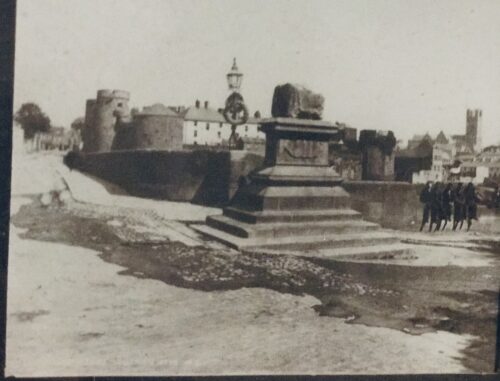
 Lovely set of 4 sepia toned hand printed framed photographs of Limerick City scenes taken from the original glass plates of the well known photographer W.Lawrence.The four scenes depict the Treaty Stone,St Marys Cathedral & ,A steamboat docked at Limerick Quays and a busy O'Connell Street scene. Origins : Co Clare Dimensions :16cm x 18cm 3kg (set of 4)
Lovely set of 4 sepia toned hand printed framed photographs of Limerick City scenes taken from the original glass plates of the well known photographer W.Lawrence.The four scenes depict the Treaty Stone,St Marys Cathedral & ,A steamboat docked at Limerick Quays and a busy O'Connell Street scene. Origins : Co Clare Dimensions :16cm x 18cm 3kg (set of 4) -
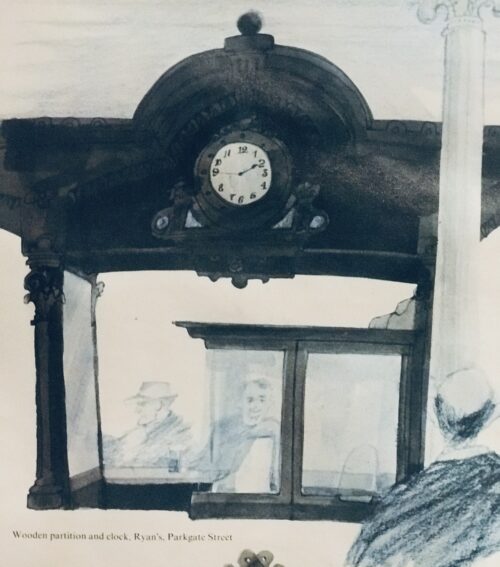
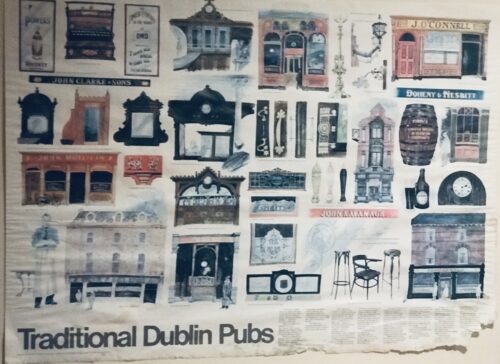 Large,colourful,beautifully illustrated and wonderfully eclectic poster depicting some of the best and most iconic Dublin watering holes.This superb poster depicts a variety of the facades,architectural features and idiosyncrasies of many of the best and most celebrated traditional Dublin public houses.Favourite watering holes featured here include; The Stags Head of Dame Court,O'Connells of South Richmond St ,Ryans of Parkgate St, Doheny & Nesbitts of Baggott St ,Ryans of Haddington Road,Slatterys of Rathmines, The Palace Bar of Fleet St,McDaids off Grafton St,Kehoe' s of South Anne St,The International Bar, The Brazen Head,Mulligans of Poolbeg St and Madigans of North Earl St to name but a few. Its fair to say another 50 of these posters could have been commissioned and you still wouldn't run out of timeless classic Dublin watering holes. 57cm x 84 cm
Large,colourful,beautifully illustrated and wonderfully eclectic poster depicting some of the best and most iconic Dublin watering holes.This superb poster depicts a variety of the facades,architectural features and idiosyncrasies of many of the best and most celebrated traditional Dublin public houses.Favourite watering holes featured here include; The Stags Head of Dame Court,O'Connells of South Richmond St ,Ryans of Parkgate St, Doheny & Nesbitts of Baggott St ,Ryans of Haddington Road,Slatterys of Rathmines, The Palace Bar of Fleet St,McDaids off Grafton St,Kehoe' s of South Anne St,The International Bar, The Brazen Head,Mulligans of Poolbeg St and Madigans of North Earl St to name but a few. Its fair to say another 50 of these posters could have been commissioned and you still wouldn't run out of timeless classic Dublin watering holes. 57cm x 84 cm -
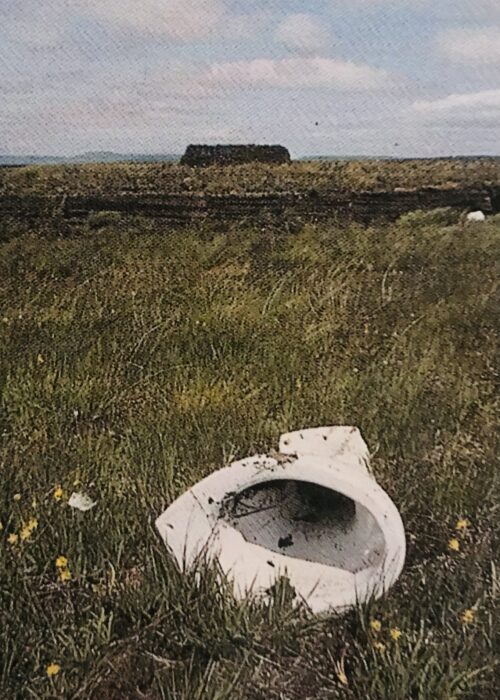
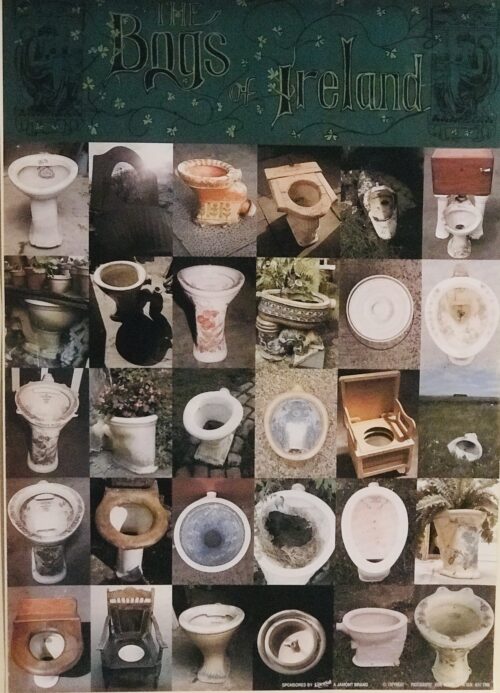 We were very fortunate to acquire this very famous poster-The Bogs of Ireland.A collage of some very interesting toilets recorded for eternity by the renowned photographer John Morris.This poster is now completely out of print and is difficult to acquire.Makes a wonderful addition to anyone's favourite sanctuary and place of solitude! Each poster is individually numbered. Dimensions : 65cm x 45cm
We were very fortunate to acquire this very famous poster-The Bogs of Ireland.A collage of some very interesting toilets recorded for eternity by the renowned photographer John Morris.This poster is now completely out of print and is difficult to acquire.Makes a wonderful addition to anyone's favourite sanctuary and place of solitude! Each poster is individually numbered. Dimensions : 65cm x 45cm -

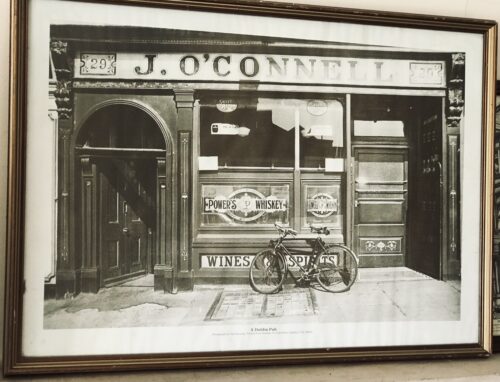 Beautiful framed print of the esteemed J.O' Connell’s Pub.29 South Richmond Street,one of the great Dublin watering holes. 48cm x 68cm Dublin "O’Connell’s, from what we can tell, is an old boozer. Our limited research skills haven’t managed to date it, but a record in ‘Thom’s Almanac and Official Directory for the Year 1862’ lists a Mr Walter Furlong – a grocer and spirit dealer, as it’s occupant. A further record from an electoral register dated between 1908 and 1915 describes the building as being a ‘Licensed House’. What’s nice though about this pub, though, is the fact that none of that is rammed down your throat. Nowadays we live in such a marketing-centric time, and it’s of particular annoyance to us when a pub which is barely opened a wet day bombards its patrons and potential patrons with a PR-spun, contrived ‘back-story’, which takes more than enough of its fair share of artistic license when deciding on how liberal to be with the truth. In J O’Connell’s this is no concern. What you do get here is an authentic Dublin boozer. The colour scheme is one that I can’t come to describe without mention of the word – festive. Glossy reds and greens cast a warming glow on the pub which is of a medium size overall. High seating is available at the bar only and a traditional combination of pub couches and low stools make up the rest. The walls display a good mix of the usual fare – horses, GAA, local history and some nice portraits of Brendan Behan & Co. Mix nicely along with the whiskey and beer trinkets about the place. Pintman Nº2 was taken with the arrangement of the shelving behind the bar and I noticed the barrel end of a few casks which sat into the bar, as they would have in the era before mainstream bottling. I wondered if they were an original feature at the time, I’m less uncertain now having discovered the age of the place. The vibe when we visited was quite a chilled one – a mix of young and old locals sat ensconced into various corners engrossed in quiet conversation. The radio was kept low enough and was playing Billie Holiday, or Billy Holiday-esque sort of tunes – we all agreed it an unusual set of tunes in the context of Dublin pubs en-masse, but too agreed that they suited the mood perfectly. The staff were excellent, the barman was on the ball with service and barely allowed us to leave our seats to obtain a jar. The pint was a bargain at €4.80 and was as satisfying on the palate as it was on the pocket. J O’Connell’s is one of the true undiscovered gems in Dublin’s landscape of pubs. And yes, the Panama Canal may be more impressive than The Grand, and there’s little doubt that the weather in the Carribean is nicer than ours. But who wants to be drinking rum in a wicker hut with sand down your trousers when you could instead be cuddled into a couch with a pint of plain in Portobello. I know which one I fancy more."
Beautiful framed print of the esteemed J.O' Connell’s Pub.29 South Richmond Street,one of the great Dublin watering holes. 48cm x 68cm Dublin "O’Connell’s, from what we can tell, is an old boozer. Our limited research skills haven’t managed to date it, but a record in ‘Thom’s Almanac and Official Directory for the Year 1862’ lists a Mr Walter Furlong – a grocer and spirit dealer, as it’s occupant. A further record from an electoral register dated between 1908 and 1915 describes the building as being a ‘Licensed House’. What’s nice though about this pub, though, is the fact that none of that is rammed down your throat. Nowadays we live in such a marketing-centric time, and it’s of particular annoyance to us when a pub which is barely opened a wet day bombards its patrons and potential patrons with a PR-spun, contrived ‘back-story’, which takes more than enough of its fair share of artistic license when deciding on how liberal to be with the truth. In J O’Connell’s this is no concern. What you do get here is an authentic Dublin boozer. The colour scheme is one that I can’t come to describe without mention of the word – festive. Glossy reds and greens cast a warming glow on the pub which is of a medium size overall. High seating is available at the bar only and a traditional combination of pub couches and low stools make up the rest. The walls display a good mix of the usual fare – horses, GAA, local history and some nice portraits of Brendan Behan & Co. Mix nicely along with the whiskey and beer trinkets about the place. Pintman Nº2 was taken with the arrangement of the shelving behind the bar and I noticed the barrel end of a few casks which sat into the bar, as they would have in the era before mainstream bottling. I wondered if they were an original feature at the time, I’m less uncertain now having discovered the age of the place. The vibe when we visited was quite a chilled one – a mix of young and old locals sat ensconced into various corners engrossed in quiet conversation. The radio was kept low enough and was playing Billie Holiday, or Billy Holiday-esque sort of tunes – we all agreed it an unusual set of tunes in the context of Dublin pubs en-masse, but too agreed that they suited the mood perfectly. The staff were excellent, the barman was on the ball with service and barely allowed us to leave our seats to obtain a jar. The pint was a bargain at €4.80 and was as satisfying on the palate as it was on the pocket. J O’Connell’s is one of the true undiscovered gems in Dublin’s landscape of pubs. And yes, the Panama Canal may be more impressive than The Grand, and there’s little doubt that the weather in the Carribean is nicer than ours. But who wants to be drinking rum in a wicker hut with sand down your trousers when you could instead be cuddled into a couch with a pint of plain in Portobello. I know which one I fancy more." -
Out of stock
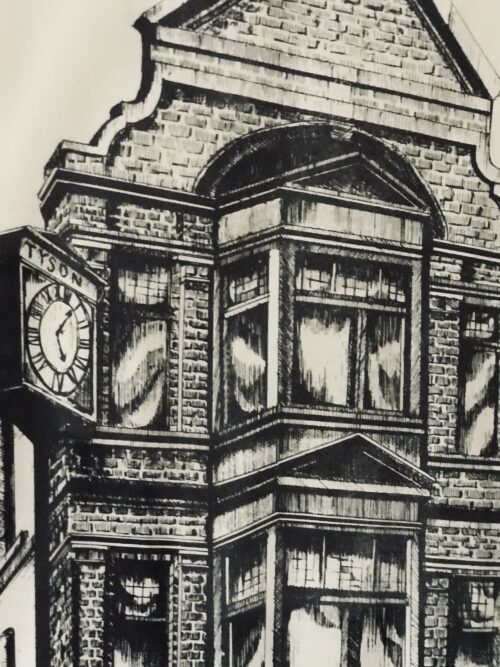
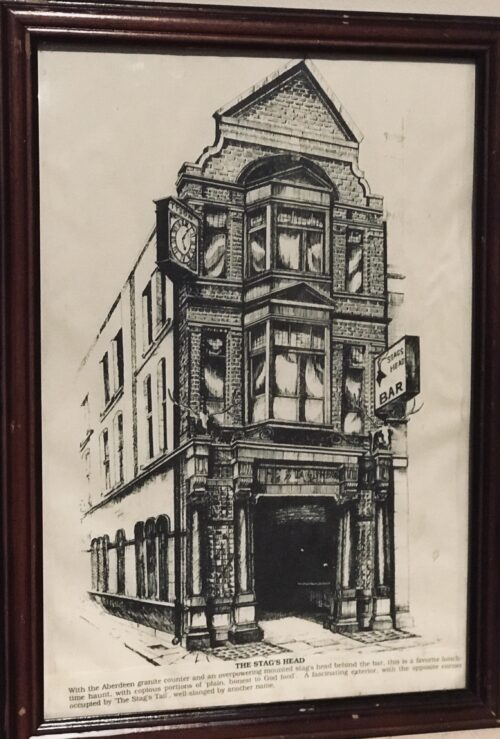 An attractive drawing of the legendary Stags Head Public House in Dublin."With the Aberdeen granite counter and an overpowering mounted stag's head behind the bar,this is a favourite lunch-time haunt, with copious portions of 'plain ,honest to god food'.A fascinating exterior, with the opposite corner occupied by 'The Stag's Tail",well slanged by another name. 40cm x 30cm Dame St Dublin The Stag's Head is a pub on the corner of Dame Court and Dame Lane in Dublin, Ireland.Records of a pub on the site of the Stag's Head date to 1770 (original construction by a Mr. Tyson) and 1895 (extensive rebuilding).The pub is known for the preservation of its Victorian interior and the restored advertising mosaic on the footpath on Dame Street, some distance from the pub's doors.The name "Tyson", and Mr. Tyson's initials, decorate the old clock and the wrought-iron of the exterior. Mr. Tyson is also believed to have contributed to the construction of a permanent pavement over Dame Lane. There is a stuffed fox on the ground floor snug of the Stag's Head, while a large stag's head decorates the main bar. The pub has appeared in many films, notably A Man of No Importance, starring Albert Finney and Educating Rita starring Michael Caine and Julie Walters. Filming for Penny Dreadful also took place both inside and outside the pub in February 2014. The establishment was sold in 2005 for €5.8M and bought by the Louis Fitzgerald Group. A number of changes have made to the pub since the sale, most notably the introduction of a television set to the bar area.
An attractive drawing of the legendary Stags Head Public House in Dublin."With the Aberdeen granite counter and an overpowering mounted stag's head behind the bar,this is a favourite lunch-time haunt, with copious portions of 'plain ,honest to god food'.A fascinating exterior, with the opposite corner occupied by 'The Stag's Tail",well slanged by another name. 40cm x 30cm Dame St Dublin The Stag's Head is a pub on the corner of Dame Court and Dame Lane in Dublin, Ireland.Records of a pub on the site of the Stag's Head date to 1770 (original construction by a Mr. Tyson) and 1895 (extensive rebuilding).The pub is known for the preservation of its Victorian interior and the restored advertising mosaic on the footpath on Dame Street, some distance from the pub's doors.The name "Tyson", and Mr. Tyson's initials, decorate the old clock and the wrought-iron of the exterior. Mr. Tyson is also believed to have contributed to the construction of a permanent pavement over Dame Lane. There is a stuffed fox on the ground floor snug of the Stag's Head, while a large stag's head decorates the main bar. The pub has appeared in many films, notably A Man of No Importance, starring Albert Finney and Educating Rita starring Michael Caine and Julie Walters. Filming for Penny Dreadful also took place both inside and outside the pub in February 2014. The establishment was sold in 2005 for €5.8M and bought by the Louis Fitzgerald Group. A number of changes have made to the pub since the sale, most notably the introduction of a television set to the bar area. -
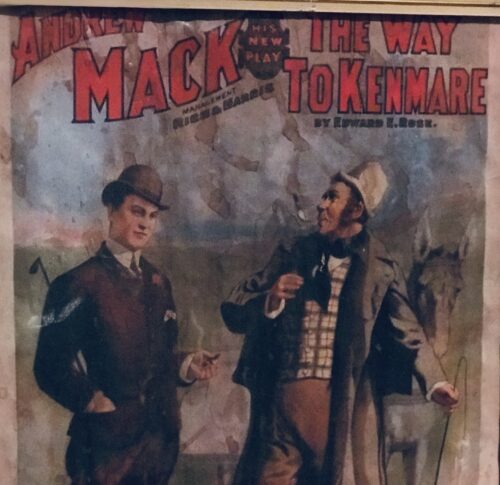

45cm x 34cm. Killarney Co Kerry
Theatrical advertising poster for "The way to Kenmare".Andrew Mack, born William Andrew McAloon, (July 25, 1863 – May 21, 1931) was an American vaudevillian, actor, singer and songwriter of Irish descent.A native of Boston, Massachusetts, he began his career at an early age in 1876 using the stage name Andrew Williams. He began in minstrel shows, and was especially associated with the song "A Violet From Mother's Grave".In 1892, he debuted in vaudeville. He composed songs for himself to sing. In 1899, he composed the popular song "The Story of the Rose (Heart of My Heart)" which became a standard of barbershop quartets.- Bluebeard's Seven Wives (1926)
-

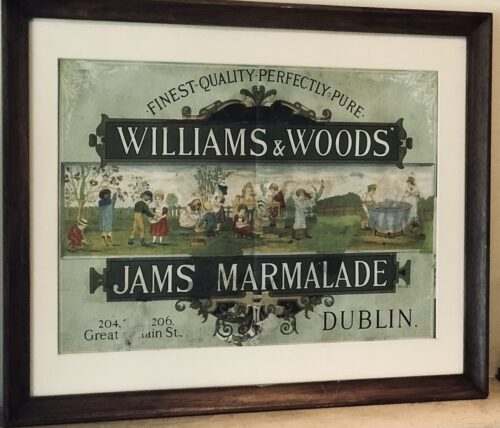 50cm x 70cm Drumcondra Dublin Once the Willy Wonka chocolate factory of Dublin,Williams & Woods kept generations of children and adults happy with their large range of confectionary items as advertised in this rare, original print from the late 1890s.The company is long gone but happily the building has been put to good use as you can read below.William's & Woods building on King's Inn Street in Dublin City Centre is where it all began - the first home to the Chocolate Factory shared creative space. Once manufacturing various sweet treats including Toblerone and Mint Crisp, this industrial building now houses an eclectic mix of small businesses and individuals in creative sectors including art, design, music, photography, craft, up-cycling, dance, illustration, graphics, events, horticulture, baking and small batch food & drink production. The incredible transformation and re-invention of Dublin's first concrete building into a creative and collaborative space continues in addition to other alternative Chocolate Factory venues around the country.
50cm x 70cm Drumcondra Dublin Once the Willy Wonka chocolate factory of Dublin,Williams & Woods kept generations of children and adults happy with their large range of confectionary items as advertised in this rare, original print from the late 1890s.The company is long gone but happily the building has been put to good use as you can read below.William's & Woods building on King's Inn Street in Dublin City Centre is where it all began - the first home to the Chocolate Factory shared creative space. Once manufacturing various sweet treats including Toblerone and Mint Crisp, this industrial building now houses an eclectic mix of small businesses and individuals in creative sectors including art, design, music, photography, craft, up-cycling, dance, illustration, graphics, events, horticulture, baking and small batch food & drink production. The incredible transformation and re-invention of Dublin's first concrete building into a creative and collaborative space continues in addition to other alternative Chocolate Factory venues around the country.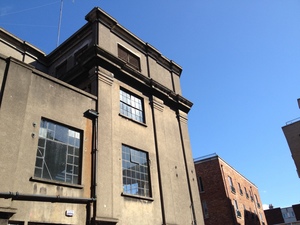
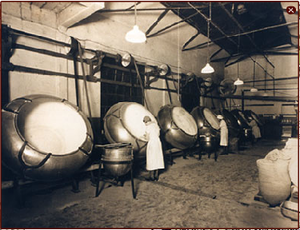
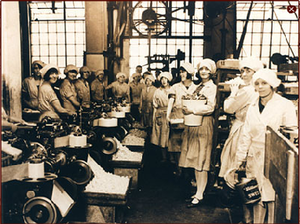
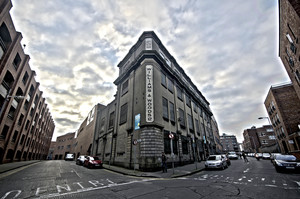 D
D
